Seasonal Allergies by Month: Your Month-by-Month Guide to Allergies
What are the highest pollen levels each month? Learn about the different types of pollen that affect seasonal allergies throughout the year in this comprehensive month-by-month guide.
Understanding Seasonal Allergies by Month
Seasonal allergies can be a frustrating and unpredictable experience, with pollen levels fluctuating throughout the year. But by understanding the patterns of different types of pollen, you can better prepare and manage your allergy symptoms. This comprehensive month-by-month guide will help you navigate the seasonal changes and stay one step ahead of your allergies.
January: Low Pollen Levels, Except for Cedar in the South
In January, pollen levels are generally low across the United States, with the exception of cedar pollen in the South. Cedar trees are a common culprit during this time of year, so if you live in the Southern states, you may experience heightened allergy symptoms.
February: Tree Pollen Starts to Increase
As we move into February, tree pollen, such as alder and maple, begins to increase in many parts of the country. This can be the start of allergy season for some individuals, so it’s important to be prepared with appropriate allergy medication and prevention strategies.

March: Tree Pollen Dominates, but Weeds and Grasses May Start
Tree pollen remains the primary concern in March, but depending on the weather and location, weeds and grasses may also start to contribute to allergy woes. If spring arrives early, you may see an earlier onset of these additional pollen sources.
April: The Height of Tree Pollen
April is often considered the peak of tree pollen season, with high levels of pollen from trees like pine, mulberry, and willow. This can be a challenging time for those with tree pollen allergies, so it’s crucial to take appropriate precautions and seek relief measures.
May: The Double Whammy of Trees and Grasses
In May, allergy sufferers face a “double whammy” as tree pollen and grass pollen both reach high levels across the country. This can be an especially difficult time for those with multiple pollen allergies, requiring a comprehensive management approach.
June: Grass Pollen Dominates
As we transition into June, grass pollen, including types like bermuda, rye, and cat, becomes the primary culprit. This is the height of grass pollen season, and it can significantly impact those with grass allergies.

July: Weed Pollen Starts to Rise
Just as we begin to get some relief from tree and grass pollen, weed pollen starts to rise in July. Weeds like pigweed, ragweed, and nettle become more prevalent, potentially causing problems for those with weed allergies.
August: Weed Pollen Peaks
August is the month when weed pollen, particularly from plants like pigweed, ragweed, and nettle, is in full effect. This can be a challenging time for allergy sufferers, as these pollen types can be particularly widespread and difficult to avoid.
September: The Height of Weed Pollen Season
September is considered the height of weed pollen season, with pollen grains that can spread easily in the wind. This is a critical time for those with weed allergies, as exposure can be difficult to manage.
October: Weed Pollen Starts to Decline
As we move into October, weed pollen levels begin to decline, especially in the North and East. However, in the South and West, weed pollen can still be a concern during this time.
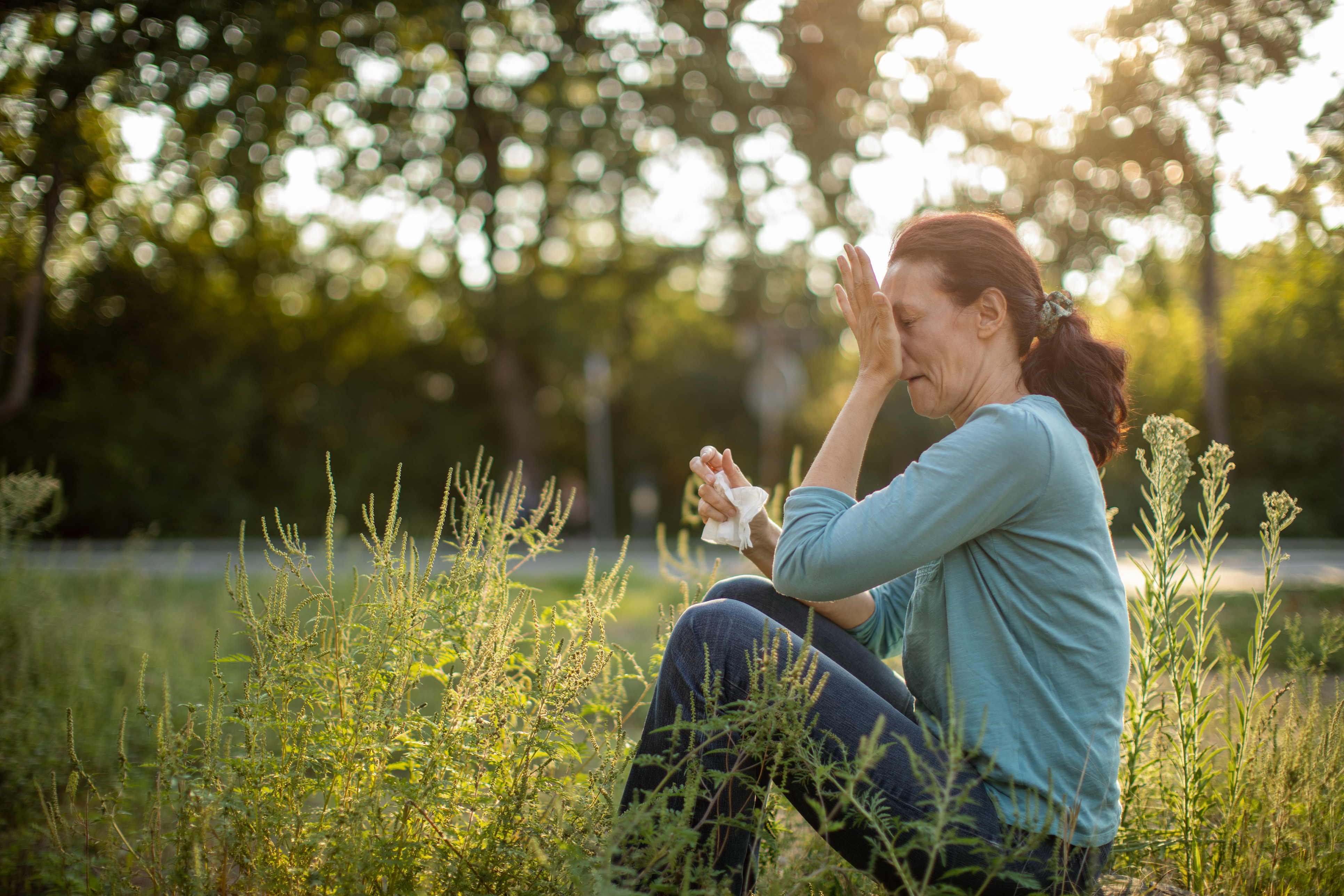
November: Outdoor Allergies Winding Down
November is generally a good month for those with outdoor allergies, as pollen levels, including ragweed, start to subside. However, in the South, the pesky Cedar Fever can still be a problem.
December: Outdoor Allergies at a Low, Except for Cedar Fever in the South
In December, outdoor allergies are typically at their lowest levels, with the exception of Cedar Fever in the Southern states. This can be a welcome reprieve for allergy sufferers, allowing them to enjoy the holiday season with fewer allergy-related disruptions.
Preparing for Seasonal Allergies
By understanding the monthly patterns of different pollen types, you can better prepare and manage your seasonal allergies. Remember to consult with your healthcare provider to develop a comprehensive allergy management plan, which may include medication, avoidance strategies, and other interventions tailored to your specific needs.
Finding Relief with ZYRTEC速
ZYRTEC速 can provide relief for pollen allergies day after day, no matter the month. With 30, 60, and 90 count options available, you can find the right ZYRTEC速 solution to meet your monthly allergy needs. Visit the ZYRTEC速 website to learn more and explore their wide range of allergy relief products.
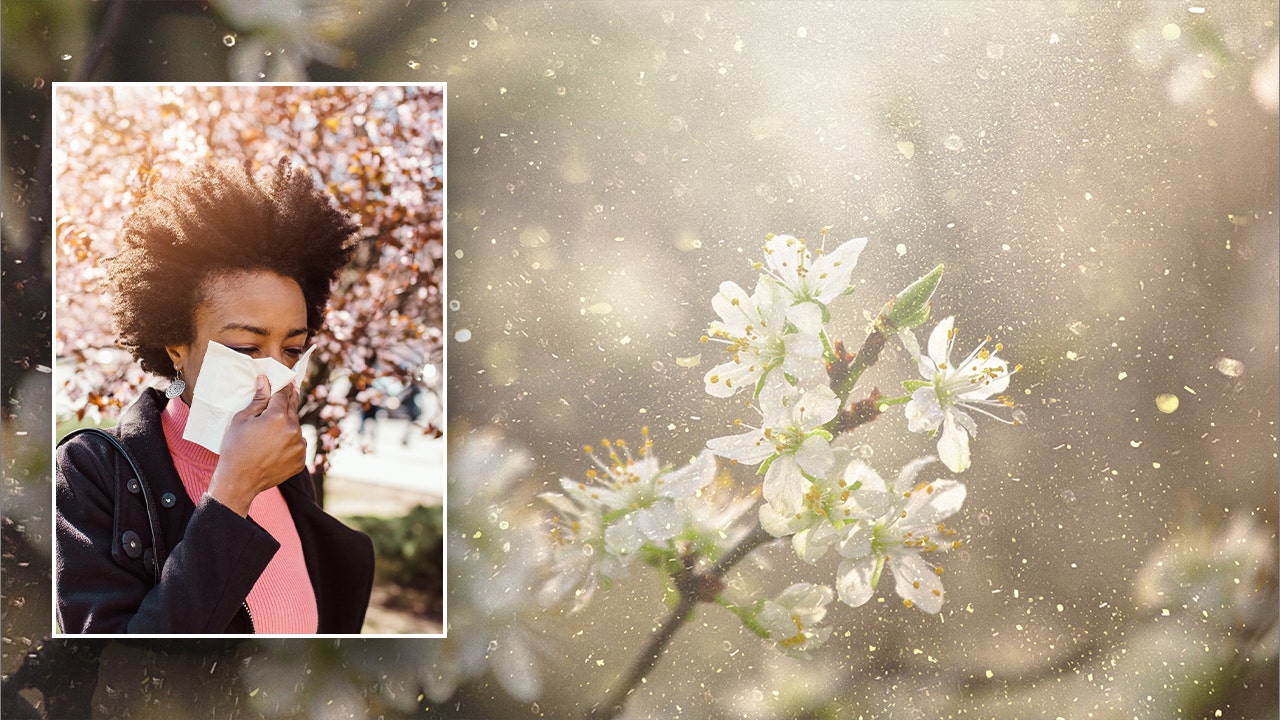
Month By Month Guide to Pollen Allergies
Month By Month Guide to Pollen Allergies | ZYRTEC®
Skip to main content
Ever wonder what the pollen is going to be like each month? The weather, location, and time of year determine which types of pollen are most prevalent. This quick guide can help you understand which months have the highest levels of pollen and help you plan ahead throughout the year.
TREES | GRASS | WEEDS | |||
JANUARYCedar is high in South but otherwise pollen is low accross the US. | |||||
FEBRUARYTree pollen, like alder and maple, is starting to creep up everywhere. | |||||
MARCHTree pollen is dominant but weeds and grasses could start if Spring comes early. | |||||
APRILThis is the height of tree pollen like pine, mulberry and willow. | |||||
MAYIt’s a double whammy month with trees and grass being high everywhere. | |||||
JUNEThis is the height of grass pollen like bermuda, rye and cat. | |||||
JULYJust as we get some relief from tree pollen, weed pollen starts in earnest. | |||||
AUGUSTWeeds like pigweed, ragweed and nettle are in full effect. | |||||
SEPTEMBERThe height of weed pollen – with pollen grains that spread easily in the wind. | |||||
OCTOBERWeeds are still high in the south and west but otherwise the air is pretty clear. | |||||
NOVEMBERIt’s a good month for outdoor allergies and ragweed is finally ending. | |||||
DECEMBEROutdoor allergies are at a low except that pesky Cedar Fever in the South. | |||||
Try ZYRTEC® For monthly allergy relief
ZYRTEC® provides relief for pollen allergies day after day. Try our 30, 60, and 90 count options for month long allergy relief, any month you need it.
More About Outdoor Allergies
Featured Product
Use only as directed.
Features From Living with Allergies
5 Allergy Friendly House Plants
Get savings now and don’t forget to look for our email newsletters with seasonal allergy tips and alerts for our biggest savings.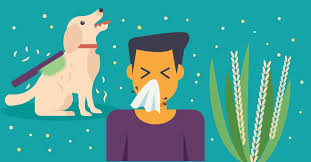
Link your social account
{* loginWidget *}
Or use your traditional account
{* #userInformationForm *}
{* traditionalSignIn_emailAddress *}
{* traditionalSignIn_password *}
Registration permits you to participate in all areas of this site. By submitting your information above, you agree that the information you provide will be governed by our site’s <a href=”/privacy” target=”_blank”>Privacy Policy</a>.
{* traditionalSignIn_signInButton *}{* traditionalSignIn_createButton *}
{* /userInformationForm *}
Welcome back, {* welcomeName *}!
{* loginWidget *}
{* #userInformationForm *}
{* traditionalSignIn_emailAddress *}
{* traditionalSignIn_password *}
{* traditionalSignIn_signInButton *}
{* /userInformationForm *}
Registration permits you to participate in all areas of this site. By submitting your information above, you agree that the information you provide will be governed by our site’s <a href=”/privacy” target=”_blank”>Privacy Policy</a>.
All Fields required, unless otherwise indicated
{* #socialRegistrationForm *}
{* socialRegistration_firstName *}
{* socialRegistration_lastName *}
{* socialRegistration_gender *}
{* socialRegistration_zipcode *}
{* socialRegistration_emailAddress *}
{% customQuestions %}
{% customOptin %}
Registration permits you to participate in all areas of this site. By submitting your information above, you agree that the information you provide will be governed by our site’s <a href=”/privacy” target=”_blank”>Privacy Policy</a>.
{* /socialRegistrationForm *}
Get savings now and don’t forget to look for our email newsletters with seasonal allergy tips and alerts for our biggest savings.
Sign in or Register to access Zyrtec Savings
Please fill-in the information below. Already have an account? <a href=”/%23″ data-capturescreen=”signIn”>Sign In</a>
Link an existing account:
{* loginWidget *}
Or create an account by providing the information below.
All fields required, unless otherwise indicated.
{* #registrationForm *}
{* traditionalRegistration_firstName *}
{* traditionalRegistration_lastName *}
{* traditionalRegistration_gender *}
{* traditionalRegistration_zipcode *}
{* traditionalRegistration_emailAddress *}
{* traditionalRegistration_password *}
{* traditionalRegistration_passwordConfirm *}
{% customQuestions %}
{% customOptin %}
{* captcha *}
Registration permits you to participate in all areas of this site. By submitting your information above, you agree that the information you provide will be governed by our site’s <a href=”/privacy” target=”_blank”>Privacy Policy</a>.
{* /registrationForm *}
{* #requirementsPostLoginForm *}
{* firstName *}
{* lastName *}
{* gender *}
{* address *}
{* zipcode *}
{* addressType *}
Registration permits you to participate in all areas of this site. By submitting your information above, you agree that the information you provide will be governed by our site’s @privacy_policy.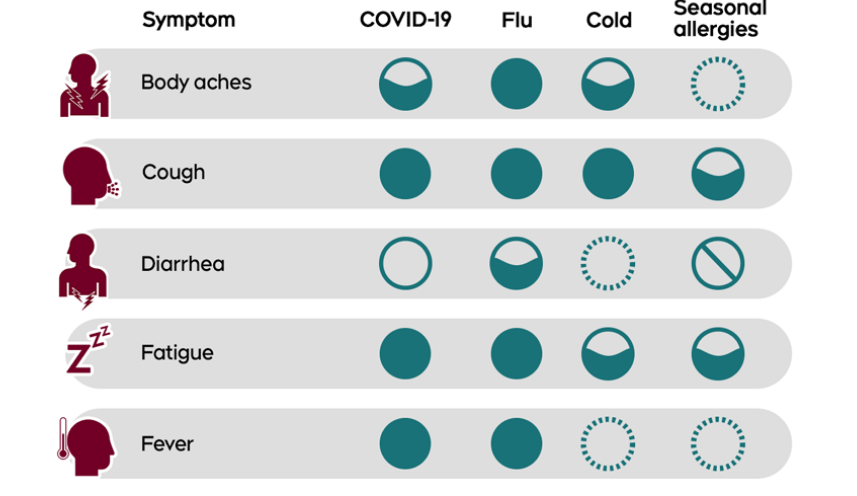
{* saveButton *}
{* /requirementsPostLoginForm *}
We’ll send you a link to create a new password.
{* #forgotPasswordForm *}
{* traditionalSignIn_emailAddress *}
{* /forgotPasswordForm *}
Looks like you have an existing account with us. We have made some changes to our site and we need you to create a new password in order to login. Click send to recieve an email with instructions on how to create your new password.
{* #optinUserNewPasswordForm *}
{* optinUser_emailAddress *}
{* /optinUserNewPasswordForm *}
We’ve sent an email with instructions to create a new password.
{* mergeAccounts *}
{* #tradAuthenticateMergeForm *}
{* traditionalSignIn_emailAddress *}
{* mergePassword *}
{* /tradAuthenticateMergeForm *}
{* #privacyPolicyPostLoginForm *}
By clicking Accept
below, you confirm that you have read, understand and accept our most recent <a href=”/privacy” target=”_blank”>Privacy Policy</a>.
{* /privacyPolicyPostLoginForm *}
You do not meet the minimum age requirement to sign in to this site
Your account is deactivated.
When Is Allergy Season 2021
Life can be rough once allergy season hits. If you’ve ever suffered from a snotty nose, watery eyes, or itchiness, then you know exactly how annoying allergy season is for many—especially when it’s finally warm enough to enjoy the outdoors again.
Allergies can be especially frustrating in a year like 2021, when most people have been limited to the confines of their homes for months on end. Plus, thanks to climate change, it turns out that people’s allergies are actually getting worse over time. Temperature increases lead to more pollen production, which can be a major irritant for those with respiratory issues like asthma, one new study suggests. In short, this might be the longest, most intense allergy season yet.
But you can fight back against your allergies, experts say, and the sooner you get started the better. That means knowing when exactly allergy season will start this year, and how to prep your body for any allergen invaders. Keep reading.
Keep reading.
When does allergy season 2021 start
?
Well, it’s technically *always* allergy season due to year-round offenders such as dust mites, mold, and pet dander, says Purvi Parikh, MD, an allergist and immunologist with Allergy & Asthma Network. But some allergens–pollens, specifically—are seasonal.
Jewelyn Butron
Tree pollen, for example, pops up in the spring (generally in late March to April), grass pollen arrives in the late spring (around May), weed pollen is most prevalent in the summer (July to August), and ragweed pollen takes over from summer to fall (late August to the first frost), says Dr. Parikh.
And, as mentioned, climate change means allergy season begins earlier and lasts longer, adds Corinne Keet, MD, PhD, a professor and allergist at Johns Hopkins University School of Medicine. Specifically, the season has been arriving 20 days earlier than it did in 1990, and contains at least 20 percent more pollen, the New York Times reported.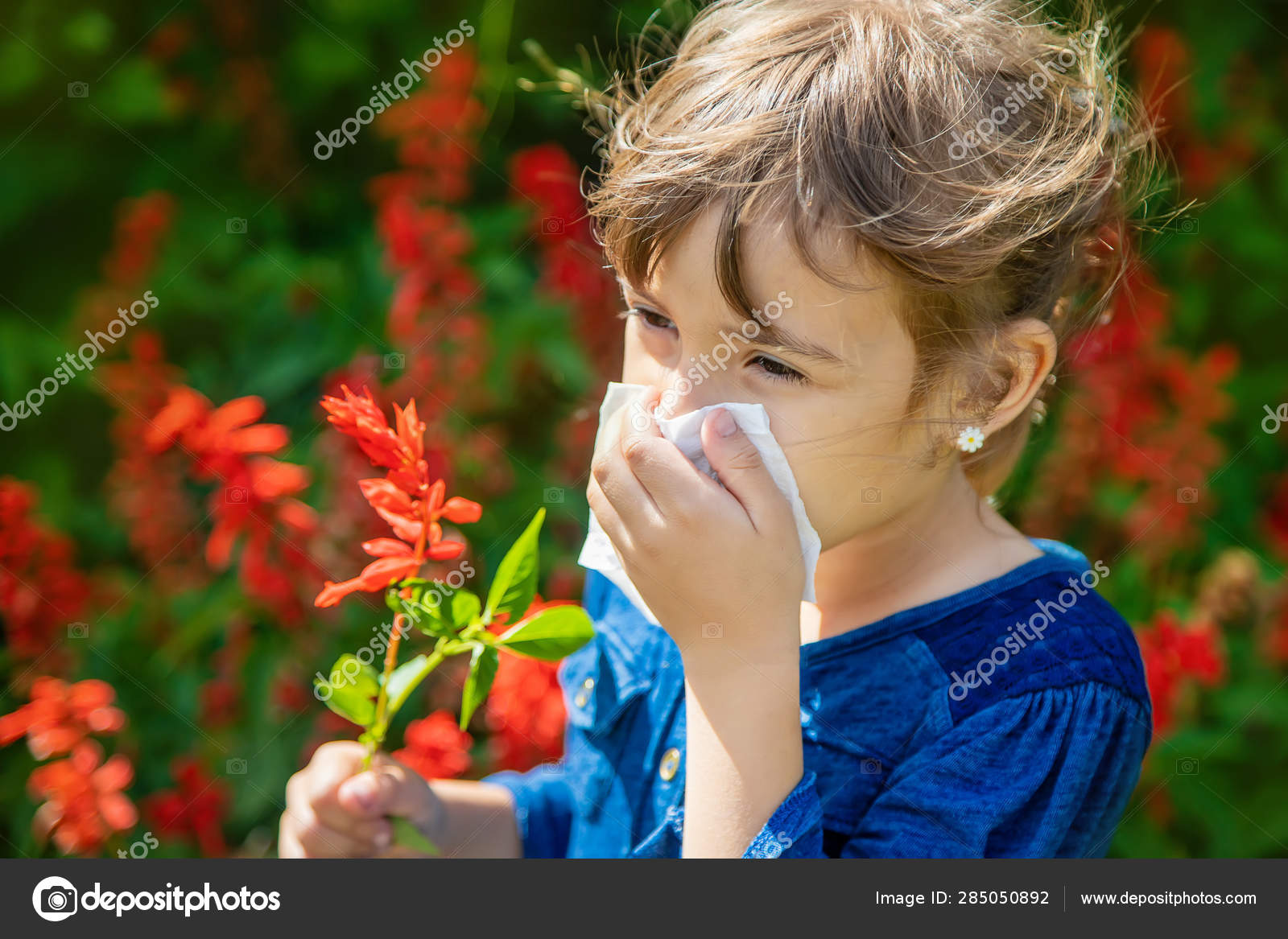
To get super-specific, Pollen.com has a National Allergy Map that provides an up-to-date allergy forecast in different areas around the country and an Allergy Alert app that gives five-day forecasts with in-depth info on specific allergens, helping you decide if you should stay indoors that day. You should also note that windy, warm, and sunny days can increase levels of pollen turnout, while drizzling or rainy weather is actually associated with no or lower levels of seasonal pollen, explains Clifford W. Bassett, MD, medical director at Allergy and Asthma Care of New York.
And while you might think that allergy season is just that, allergies, it actually poses a pretty significant health risk depending how severely your area is hit. For people with major lung issues like asthma, allergens like pollen exposure can be a major threat to their physical health, ability to breathe, etc. Research also shows that kids perform worse in school during allergy season, and that pollen exposure weakens your immune system’s ability to fight off respiratory illnesses.
When should I start taking allergy meds?
There’s no point in waiting until you’re miserable to take allergy meds, especially if you want to keep up your outdoor workouts. In fact, allergists recommend you start taking meds a couple weeks before allergy season arrives, or, at the latest, take them the moment you begin having symptoms, says Dr. Parikh. Taking them early can stop an immune system freak-out before it happens, lessening the severity of symptoms, he adds. Check out the National Allergy Map to figure out when to start taking meds depending on where you live.
As for which allergy meds to take, if you’re seriously stuffed, start with steroid nasal sprays such as Flonase or Rhinocort, which reduce inflammation-induced stuffiness, says Dr. Keet. And if you’ve got itching, sneezing, and a runny nose, too, look for non-sedating antihistamines such as Zyrtec, Xyzal, or Allegra, she adds. Just remember: While OTC allergy meds suppress symptoms, they don’t cure the problem, so they may be less effective if your allergies are worsening, notes Dr.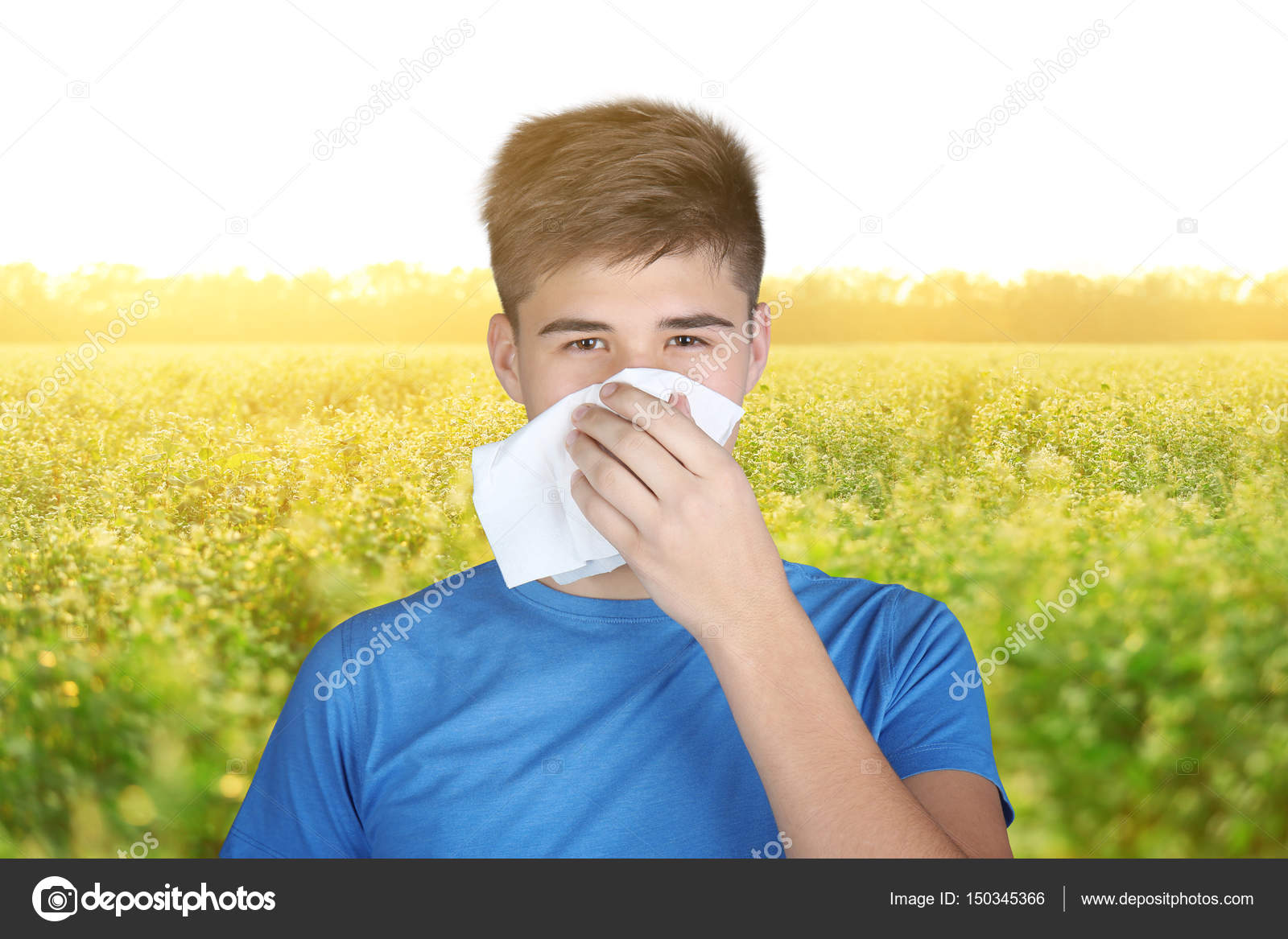 Parikh.
Parikh.
What can I do if my allergy meds aren’t working…or my allergies are getting worse?
If you’re already taking OTC allergy meds (and, you know, keeping your windows closed and washing your face and hair after coming inside), allergy shots, a.k.a. allergen immunotherapy, make your immune system less reactive to allergens (read: pollen), and for some people, they can even induce a cure, says Dr. Parikh.
This content is imported from {embed-name}. You may be able to find the same content in another format, or you may be able to find more information, at their web site.
“By giving small increasing doses of what you are allergic to, you train the immune system to slowly stop being as allergic,” she says. “This is the best way to address allergies, as it targets the underlying problem and builds your immunity to a specific allergen.”
The downside? Allergy shots are a bit of a time commitment. You’ll need to get them once a week for six to eight months, then once a month for a minimum of two years, says Dr.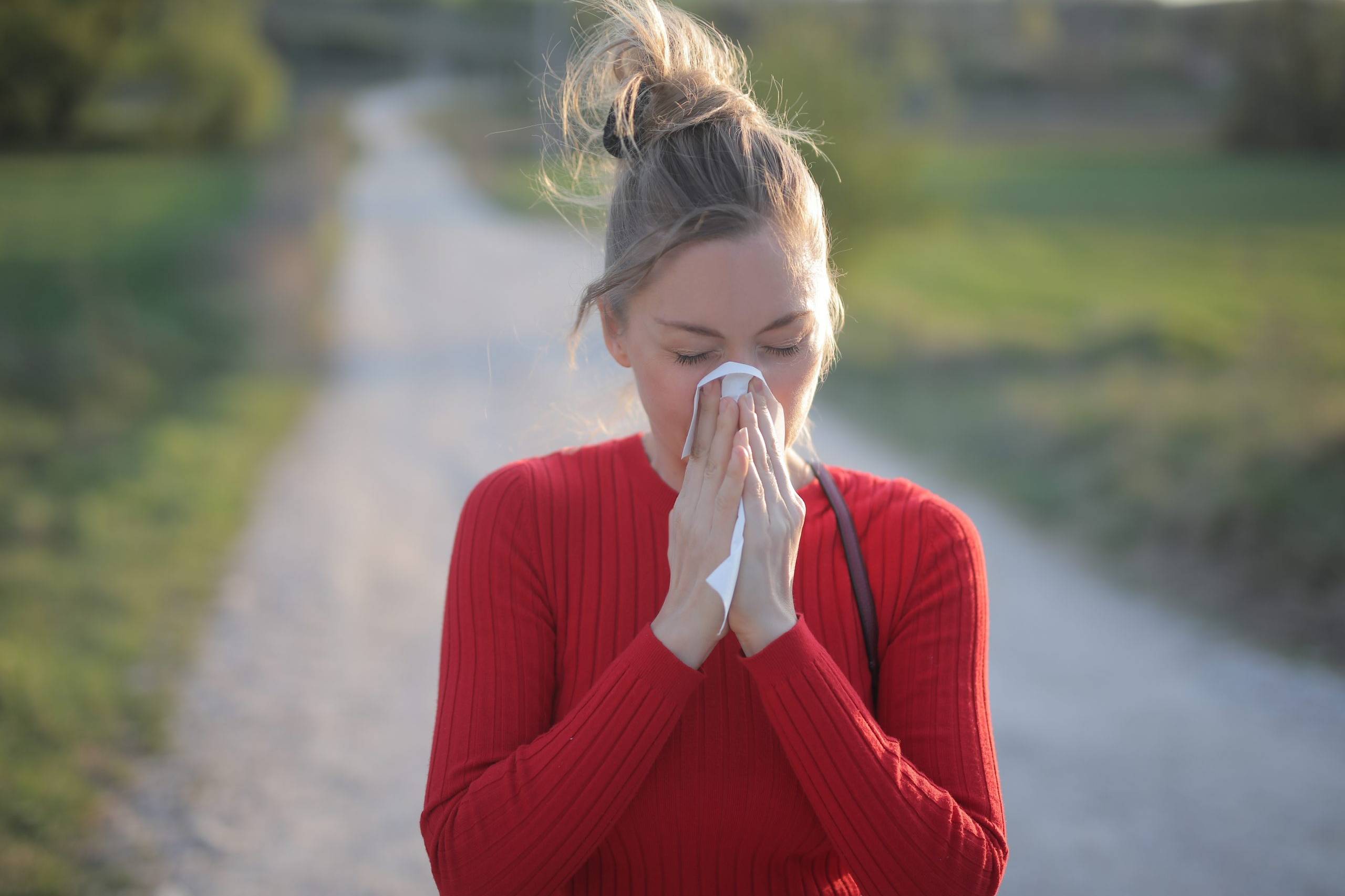 Parikh. You need to be a little bit patient, too, because it can take about six months to start feeling better (so if you want protection by March, you’ll probably have to start in September the year before). But a life without allergies? Sounds worth it to me.
Parikh. You need to be a little bit patient, too, because it can take about six months to start feeling better (so if you want protection by March, you’ll probably have to start in September the year before). But a life without allergies? Sounds worth it to me.
How can I tell if my symptoms are allergies or COVID-19?
Before you stress out, know that there’s one positive aspect when it comes to allergens in the year 2021: “Masks mean less inhalation of pollen through the nose or mouth, and that may translate to decreased symptoms for some sufferers,” explains Manisha Relan, MD, a board-certified allergist. Noted!
That said, if you’re worried about telling the difference between symptoms, whenever they do arise, listen up: The COVID and allergy symptoms that typically overlap are headaches, wheezing, and sore throat. It’s also possible to experience nasal congestion, a runny nose, and sneezing with COVID, too, though these are more commonly allergy symptoms.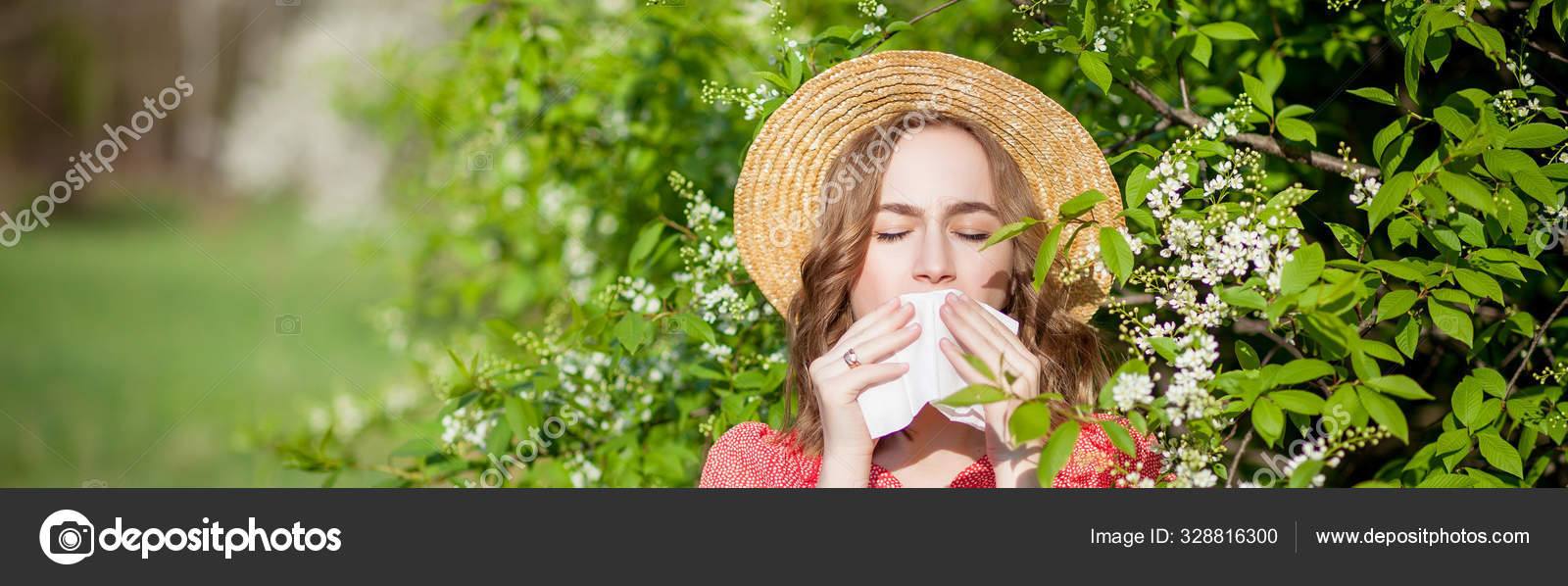 A dry cough, shortness of breath, and loss of smell, are all likely COVID-19 symptoms, though there’s always the possibility that these are the side effects of allergies.
A dry cough, shortness of breath, and loss of smell, are all likely COVID-19 symptoms, though there’s always the possibility that these are the side effects of allergies.
Overall, though, if you’re having trouble telling if your symptoms are allergies or COVID, your best bet is to check in with a doctor’s office or urgent-care center.
Cassie Shortsleeve
Freelance Writer
Cassie Shortsleeve is a skilled freelance writer and editor with almost a decade of experience reporting on all things health, fitness, and travel.
Kristin Canning
Kristin Canning is the features director at Women’s Health, where she assigns, edits and reports long-form features on emerging health research and technology, women’s health conditions, psychology, sexuality, mental health, reproductive justice, wellness entrepreneurs, women athletes, and the intersection of health, fitness, and culture for both the magazine and the website.
This content is created and maintained by a third party, and imported onto this page to help users provide their email addresses. You may be able to find more information about this and similar content at piano.io
Achoo! Breaking down allergies by month
If you suffer from seasonal allergies, you know that certain times of the year are worse than others.
What You Need To Know
- You may suffer from allergies at different times of the year
- Tree pollen emerges in the spring months
- Grass and ragweed pollen occur in the summer and fall
- Indoor allergens are around year round
Allergens change depending on the time of year. That’s because certain allergens emerge at different times of the year. Seasonal allergies may have you sneezing and coughing with itchy, watery eyes. You may also feel congested and fatigued.
Milder winters mean trees tend to bloom and pollinate sooner rather than later. With climate change and spring coming earlier and earlier, allergy season is also coming sooner and lasting longer than before.
With climate change and spring coming earlier and earlier, allergy season is also coming sooner and lasting longer than before.
Mold and indoor allergens can occur year round, but tree, grass and weed pollen occur seasonally. The best way to tackle these allergies is to take medications to ease their effects on you.
Let’s dig deeper and break down the top allergens month by month.
February – April
Trees are the main offenders during this time. If the winter is mild, trees can start pollinating as early as February. If the air temperature is consistently above 50 degrees, trees pollinate, sending the allergens into the air.
If the winter is cold and longer, tree pollen can be delayed into March and linger well through April. Oak and cedar trees are the first to pollinate with pine, birch and mulberry trees in April.
May – June
Next up is grass pollen through the summer months. Sometimes, grass and tree pollen can overlap, making you sneeze and wheeze more and even longer depending on your allergy. Grass pollen can also linger into July.
Grass pollen can also linger into July.
July – October
By late summer and into fall, weeds pollinate. The main weed that causes problems for people is ragweed. The peak of ragweed season is the middle of September, but depending on the first freeze, it can last a little longer.
November – January
During the winter when trees and grasses are in their dormant state, indoor allergens, like mold spores, are the top causes for allergies. Also, as you spend more time indoors, pet dander and dust mites may bother you as well.
You can reduce indoor allergens by changing your bedding regularly, vacuuming often and purchasing a humidifier to keep your home from becoming too dry.
Don’t worry! There are some things you can do to help ease some of your seasonal allergies.
Pollen Throughout the Year | Family Allergy & Asthma
Pollen varies depending on the area of the country, and when pollen releases into the air can depend on the winter weather. A more mild winter will encourage the trees to bloom sooner, while if our winter lasts into March, it can delay the tree blooms. Over the last few years, you may have heard that each year is the worst year ever for pollen as allergy sufferers are hit with a “Pollen Vortex” or “Pollen Tsunami”. While these reports may exaggerate the uniqueness of the weather, warmer temperatures can cause the pollen counts to be higher sooner.
A more mild winter will encourage the trees to bloom sooner, while if our winter lasts into March, it can delay the tree blooms. Over the last few years, you may have heard that each year is the worst year ever for pollen as allergy sufferers are hit with a “Pollen Vortex” or “Pollen Tsunami”. While these reports may exaggerate the uniqueness of the weather, warmer temperatures can cause the pollen counts to be higher sooner.
For Kentucky pollen allergy sufferers, it’s always a good idea to keep an eye on pollen counts. This can help you plan your day and remind you to take medications as recommended. You can find pollen counts on our website, patient app, or you can visit Weather.com who uses data from the NAB.
Family Allergy & Asthma runs National Allergy Bureau (NAB) certified pollen counting stations in Kentucky. If you’d like to learn more on how we track pollen, check out our blog, What is a Pollen Count?. Pollen has a predictable release pattern every year. This means once you know the pollen to which you are allergic you can prepare before the pollen arrives.
Types of Pollen Found
Here is a breakdown of the types of pollen we’ll see during a year:
February – April
Trees often start pollinating as early as February. During a mild winter, temperatures might reach 50 degrees sooner, once the temperature stays above 50 for a few days the trees will begin to pollinate. If we have a longer colder winter, this could delay pollen by a few weeks into early March. Different trees will pollinate at different times. The early offenders we find in our pollen counts are Oak and Cedar trees; these trees start to pollinate in February or early March. Next, we see Willow, Pine, Birch, and Mulberry pollinating in April. As we move into May grass pollen starts to show up in our counts, and tree pollination stagnates, falling off mid-June.
May – June
Grass pollen is our main summer culprit. For people with both grass and tree pollen allergies, May can be a rough month, as the pollen season overlap.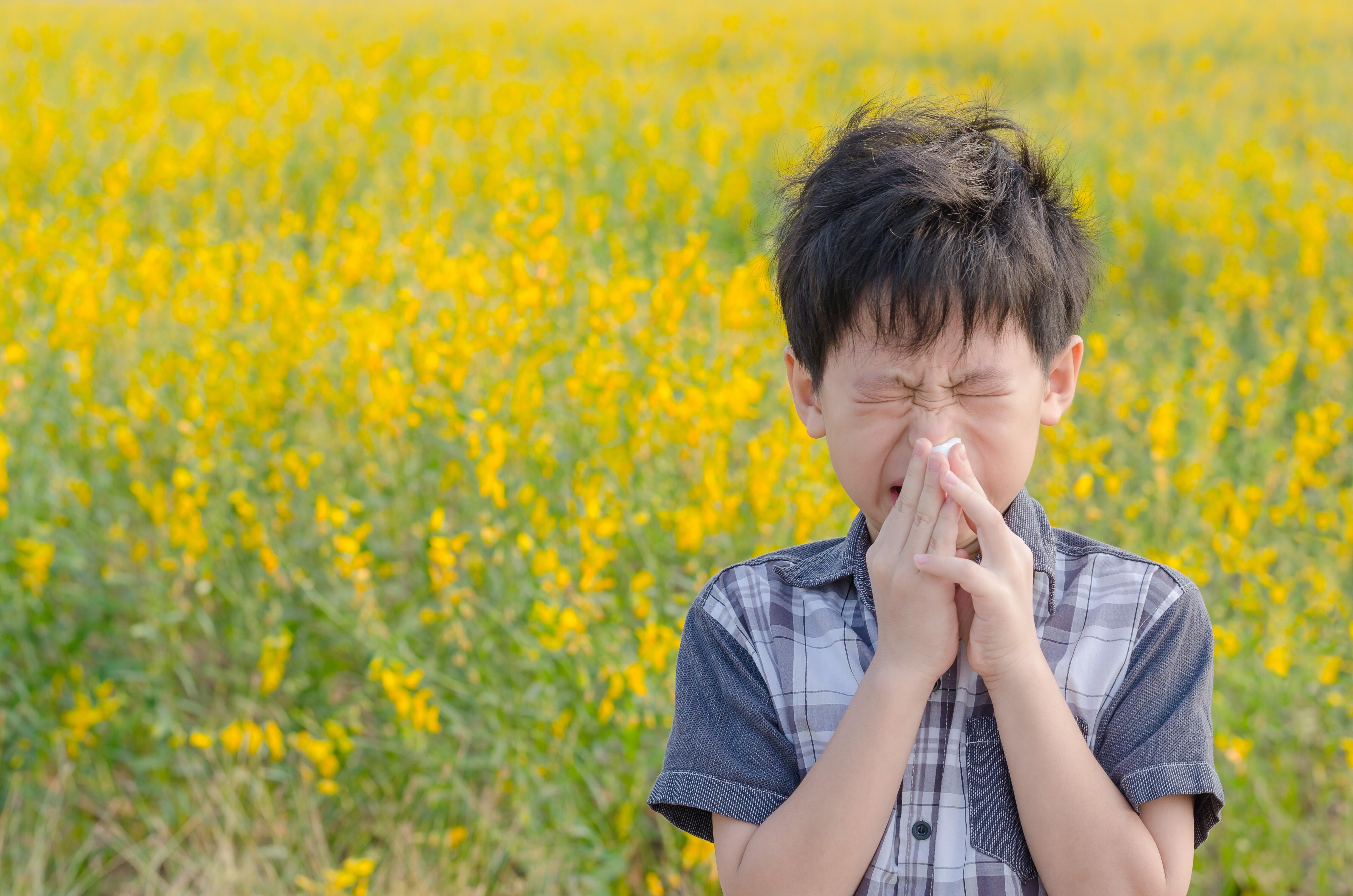 We start seeing Poaceae pollen or grass pollen in our daily pollen counts. The Poaceae grass family includes Kentucky bluegrass, bermuda, redtop, orchard and timothy grasses. We typically see grass pollen lasting through July as we start to see the appearance of weed pollen.
We start seeing Poaceae pollen or grass pollen in our daily pollen counts. The Poaceae grass family includes Kentucky bluegrass, bermuda, redtop, orchard and timothy grasses. We typically see grass pollen lasting through July as we start to see the appearance of weed pollen.
July – October
Weed pollen, or mainly, Ragweed pollen is notorious for allergies in this part of the country during the fall. Dock or sorrel pollen also appears in our counts. Ragweed is also synonymous with causing hay fever or seasonal allergies. Ragweed peaks in mid-September but can last through October depending on the first freeze of the year.
November – Jan
Winter weather may bring relief for those with pollen allergies in this region of the country! After the first freeze, most pollen counts drop to absent. Allergens still appear in the winter, for instance, mold spores. Mold counts tend to rise and fall year-round, thriving in damp environments, it can grow outdoors and in your home.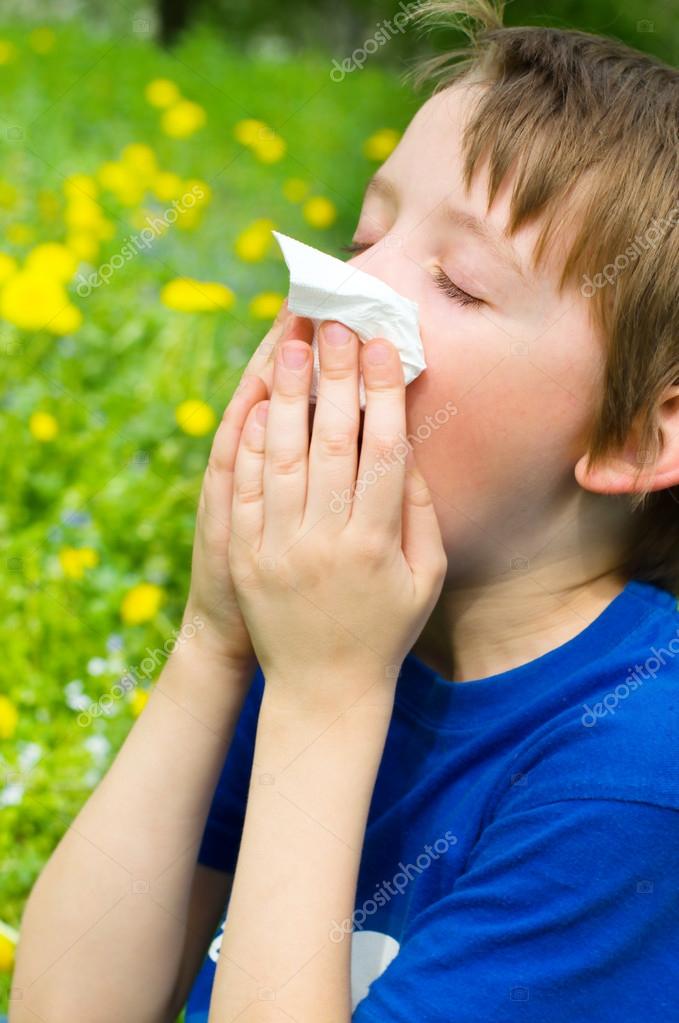
The winter months also send people indoors where they spend more time around indoor allergens like dust mites or pet dander. Learn how you can reduce indoor allergens in your home with these five tips.
Check out the below infographic for a birdseye view of when pollen appears in Kentucky and how we count it. If your allergies are getting worse, schedule an appointment with our allergists and our doctors will help get you back on track.
Infographic: Kentucky Pollen Throughout the Year
Seasonal Allergies
Seasonal Allergies
An allergy is when your body reacts badly to something that doesn’t bother most people.
Someone can be allergic to:
- A food
- A medicine
- A cat or dog
- A plant or flower
Some allergies happen mostly during the spring, summer or fall.
- These are called “seasonal allergies”.

- Seasonal allergies can also be called “hay fever.”
You may have seasonal allergies if, each year at the same time, you:
- Have itchy, watery eyes
- Have a stuffy or runny nose
- Have an itchy nose and throat
- Have a swollen face or a headache
- Sneeze or cough a lot
- Have trouble breathing
Why do seasonal allergies only happen during certain seasons?
- Because seasonal allergies are caused by pollen.
- Pollen is powder that comes from trees, weeds and grasses as they grow during the year.
Pollen is tiny and blows in the air – like dust.
- When you breathe it in you may have an allergic reaction.
- The level of pollen in the air can be different on different days.
- To find out how much pollen is in the air where you live, check out this website.
Seasonal allergies are very common.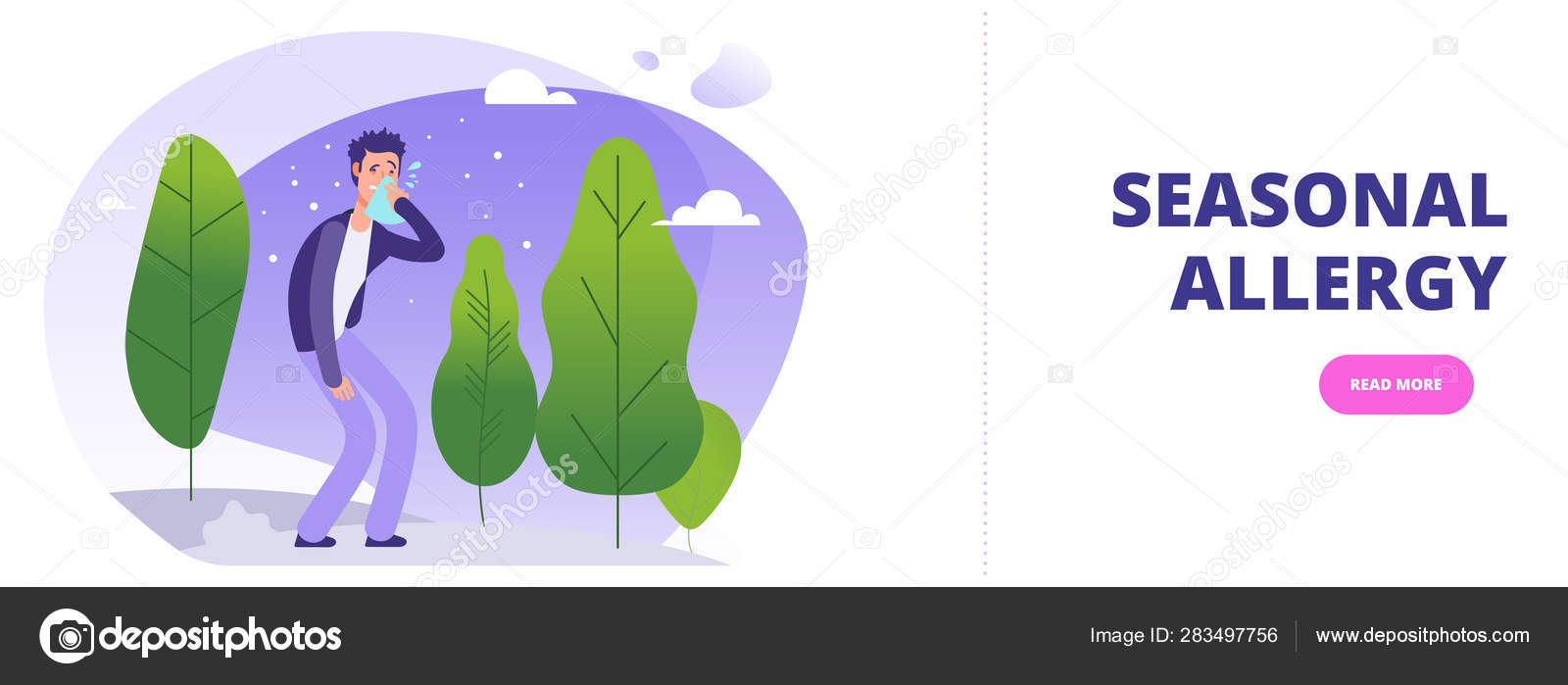 One out of five people has one.
One out of five people has one.
- You’re even more likely to have a seasonal allergy if:
- You’re allergic to other things like dust or animals
- You have asthma or eczema
- Other people in your family have seasonal allergies
- People with seasonal allergies are more likely to develop asthma.
Seasonal allergies can make it hard for you to breathe.
- It’s important to get treatment.
- Call your doctor’s office and describe your symptoms.
- Follow your doctor’s orders.
How is a seasonal allergy different from a cold or the flu?
- Seasonal allergies can make you sneeze and cough, have a stuffy or runny nose, or swollen sinuses.
- But a cold or the flu can make you feel the same way!
If you are allergic to pollen, try to avoid it.
- Stay inside on warm, windy days when lots of pollen is in the air.

- Use air conditioning and air filters at home.
- Change your furnace filters regularly.
- Close car windows.
- Wear a dust mask and wrap-around sunglasses outside.
- Take a shower to rinse pollen off yourself.
It’s easy to treat some allergies.
- If you have a stuffy nose, a hot shower may help you breathe more easily.
- If your eyes are swollen and itchy, cover them with a cool, damp cloth.
- Ask your doctor about other ways to relieve allergy symptoms without medicines.
Medication can treat serious allergy symptoms.
Your doctor may give you medication that can:
- Clear your nose
- Stop itchy eyes
- Control your allergic reaction
Talk with your doctor before you take any medication – even over-the-counter medication advertised on TV!
You can check out these links to learn more about seasonal allergies:
A Month-by-Month Guide to Seasonal Allergies in Richmond, Virginia
We often think of spring as “allergy season. ” But if you’re an allergy sufferer, every season can seem like allergy season. What steps can you take to keep your allergies from becoming an irritation all year round?
” But if you’re an allergy sufferer, every season can seem like allergy season. What steps can you take to keep your allergies from becoming an irritation all year round?
Common Allergy Symptoms
Allergic reactions occur in two phases: the histamine reaction and the delayed response. The histamine reaction happens upon immediate exposure to allergens. Meanwhile, the delayed response happens after allergen exposure over a long period of time.
Someone experiencing a histamine reaction might have these symptoms:
- Itching eyes
- Itchy throat
- Runny nose
- Sneezing
- Eye irritation
- Nasal congestion, which tends to build up the longer other symptoms go on.
The delayed response happens as a result of chronic inflammation. It usually manifests as bad nasal congestion and irritation that worsens over time.
Make an appointment to speak to an ENT doctor about your allergies.
Seasonal Allergens
When we talk about allergens, we’re mainly talking about pollen, which comes from the flowers of plants and trees. Because different flowers and trees produce pollen at different times, there’s no “one” season for allergies.
Because different flowers and trees produce pollen at different times, there’s no “one” season for allergies.
Spring Allergens
The period from late February to summer tends to be the worst for many allergy sufferers. Tree pollens such as oak, maple, and river birch are blooming during this time. The dry wind we see in early spring will spread allergens and raise the pollen count. Spring rains often flush everything down to the ocean and drop pollen counts. However, this warm wet weather can cause mold count to rise — meaning trouble for those with mold allergies.
Summer Allergens
From June to August and even September is the season for grass pollen allergies. Grass is growing everywhere, and grass pollen is a potent allergen, meaning those allergic to it will suffer the most during this time of year. The hot, humid weather will mean continuing difficulty for those allergic to mold.
Read more: How Your Air Quality Affects Your Allergies
Fall Allergens
Fall is the season for weed pollens — ragweed, thistle, goldenrod and more. From late summer into the fall, these allergens can persist until the first hard frost of the year. As with the spring, dry wind can make airborne allergies a nuisance.
From late summer into the fall, these allergens can persist until the first hard frost of the year. As with the spring, dry wind can make airborne allergies a nuisance.
Winter Allergens
It’s true there are no defined seasonal allergens in the winter. However, the things you’re allergic to the rest of the year will still be around: dust mites, pets, and so on. The dryness and coldness of the air can also cause congestion. During the winter, you should manage your environment to reduce your exposure to indoor allergens.
Read more: Can an ENT doctor treat my allergies?
What Can You Do to Manage Your Allergies?
While it’s difficult to entirely eliminate the effects of allergens on your body, there are steps you can take to make the symptoms less severe. Over-the-counter medications and antihistamines can treat allergies for a few weeks without a problem, and nasal steroid sprays work well for chronic symptoms. Other solutions include:
If you have seasonal allergies and work outside, change out of your daytime clothes once you’re home.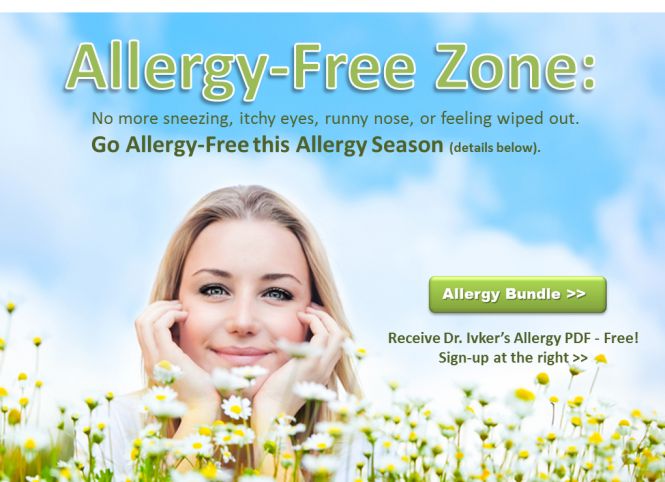 This will reduce your exposure to any allergens collected during the day.
This will reduce your exposure to any allergens collected during the day.
- Wash your sheets weekly to reduce allergen buildup.
- Keep your windows closed.
- Stay inside from 10am to 4pm if possible.
- Saline sinus rinses help flush out allergens and limit the allergic reaction.
- If you’re allergic to your pets, keep them out of your bedroom.
- Plan ahead for next month’s allergy. If you know oak tree pollen will be high in March and April, start taking medication in February.
No one likes allergies. With a few lifestyle changes and basic caution, you can manage your allergies and get back to your life.
If you have questions about seasonal allergies, or think your allergy-like symptoms may be a sign of something else, contact Virginia ENT to schedule an appointment today.
10 Easy Ways to Beat Seasonal Allergies When the Pollen Count Spikes
Seasonal allergies are usually caused by three main types of pollen: trees, grass, and weeds.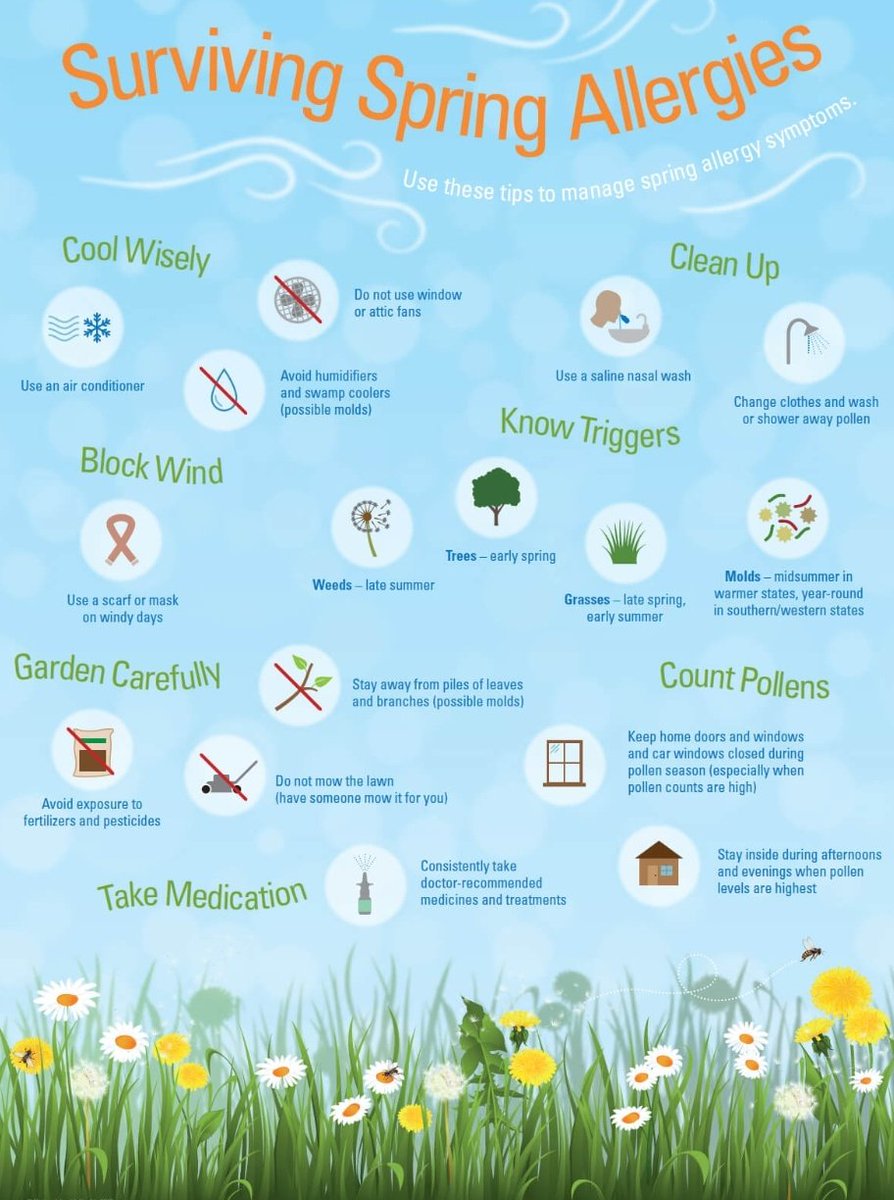 They’re called “seasonal allergies” because each type of pollen has a season where they’re most potent. Here’s a general timeline of common pollen seasons:
They’re called “seasonal allergies” because each type of pollen has a season where they’re most potent. Here’s a general timeline of common pollen seasons:
When you’re monitoring pollen counts for your specific allergy, here are 10 ways to cope:
Pollen counts tend to rise on dry, warm, and windy days, so if it’s breezy outside, try to stay indoors.
Pollen counts are highest in the morning and again at night, so if you need to go outside, try to do it when counts are low.
When it comes to seasonal allergies, it’s important to know exactly what you’re allergic to so you can take appropriate action.
“I have patients who come in saying they’re allergic to pets, then we perform a skin test and it turns out they’re actually allergic to oak trees or another pollen the pet is bringing inside on their fur,” says Erin Willits, MD, an allergist and immunologist at Intermountain Alta View Hospital.
Simply monitoring the pollen count each day isn’t effective. If you don’t know what you’re allergic to, it’s hard to limit exposure.
“Some people think if there’s an oak tree in their yard, they need to stay away from it,” Dr. Willits says. “But if the pollen count for oak trees is high, it flies everywhere, and you’re going to be exposed to allergens regardless.”
If you know you experience allergies each year, start your allergy regimen about a month before your specific allergy season starts. That way any medication has a chance to get into your system and start working before the season starts.
It might be tempting to let the crisp spring breeze into your home, but when you suffer from allergies, you just might be opening Pandora’s box. Instead turn on the air conditioner to keep the pollen out and the temperature cool in your home.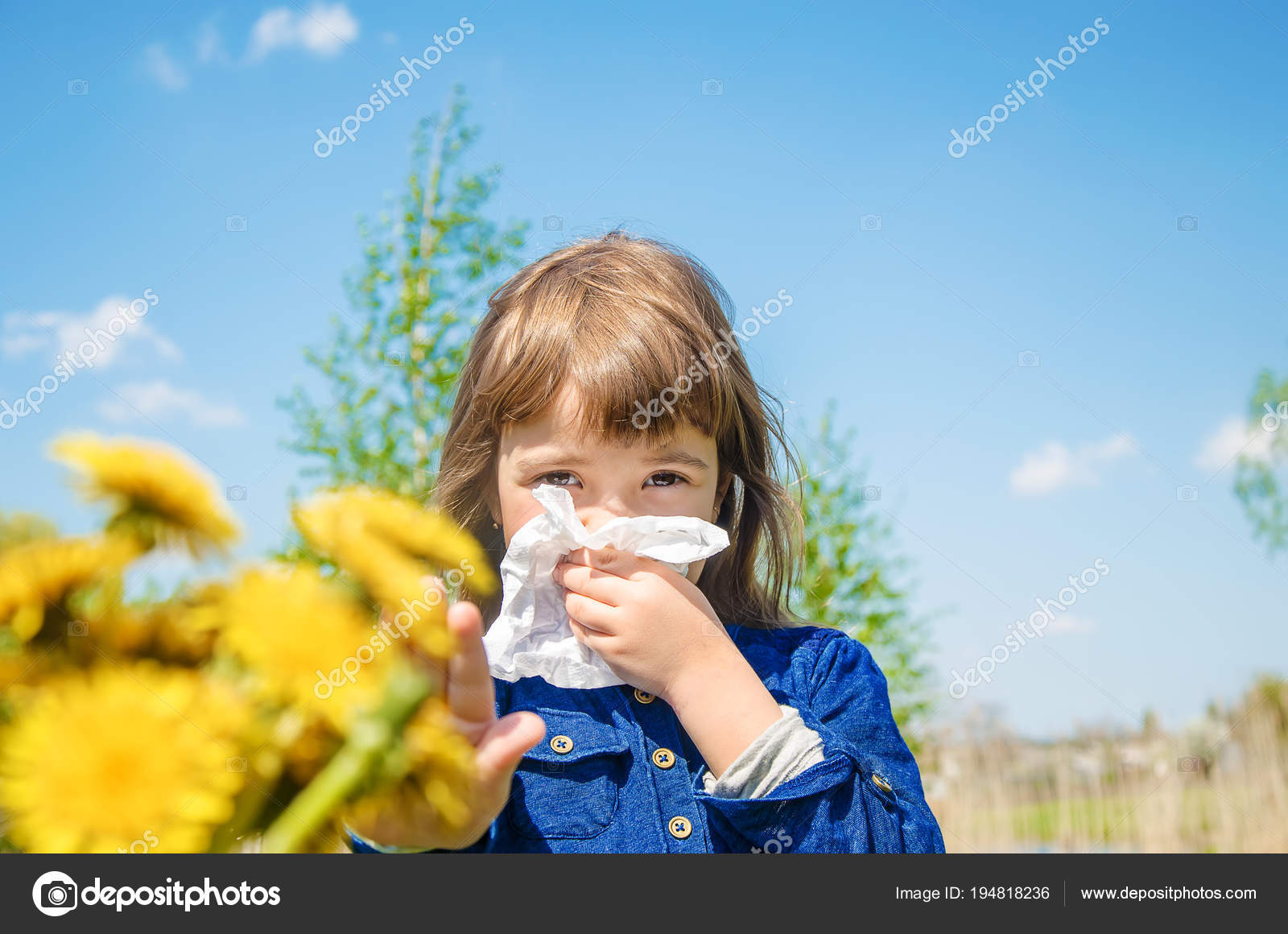
Keeping your home free of dust can make a big difference in keeping your seasonal allergies under control. Dust contains pollen and other irritants that can trigger your allergies. In addition, cigarette, cigar, and other types of smoke – including fumes from a wood-burning stove – make allergy symptoms worse, so steer clear of these irritants to help keep your allergies at bay.
Because pollen can stick to your clothes, skin, and hair, it’s important to shower each night to remove any irritants. Remember to also remove and wash any clothing that was exposed to the pollen. You’ll sleep better at night if the pollen doesn’t have a chance of getting into your bed.
Take an antihistamine before you go outside to mow the lawn, rake leaves, play with your kids, and other activities that result in pollen exposure.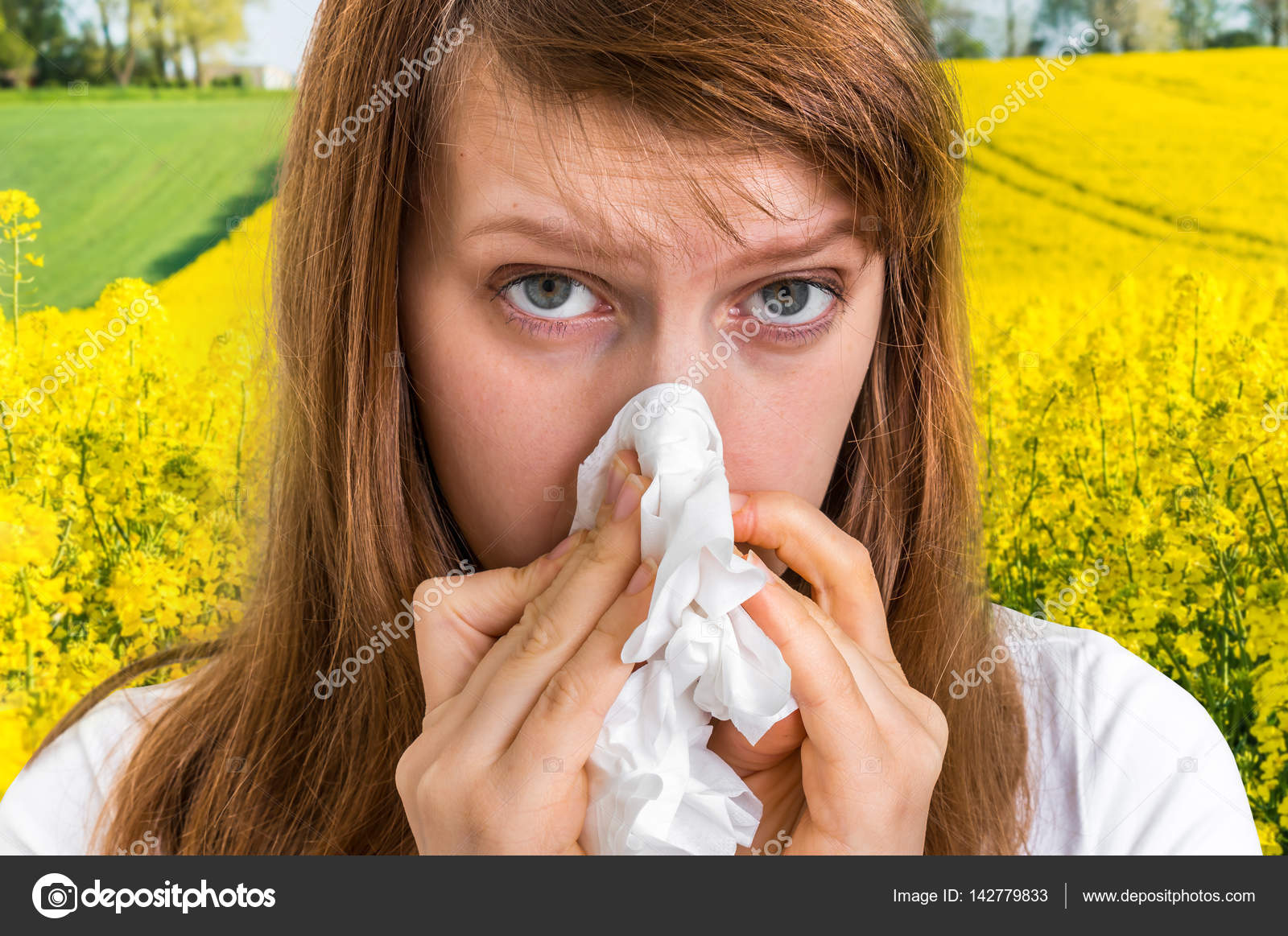 Wearing a pollen mask is also an easy way to reduce exposure to irritants. Pollen masks are available at most pharmacies for additional protection against allergens.
Wearing a pollen mask is also an easy way to reduce exposure to irritants. Pollen masks are available at most pharmacies for additional protection against allergens.
This one may sound like a no-brainer, but if you’re allergic to pets, don’t get one. If you have a pet, at the very least, keep them out of your bedroom and off of your bed. And even if you’re not allergic to pets, they can carry pollen on their fur, brush their hair frequently, wash your hands after touching them, and never rub your eyes after petting them. Vacuuming your house at least once per week can also do wonders to keep pet dander at bay.
Some people can have a mold-specific allergy – both indoor and outdoor mold. One way to lessen mold in your home is to wipe away any standing water in the bathroom and shower area. Using a ventilation fan when you take a shower also helps to reduce the chance of mold.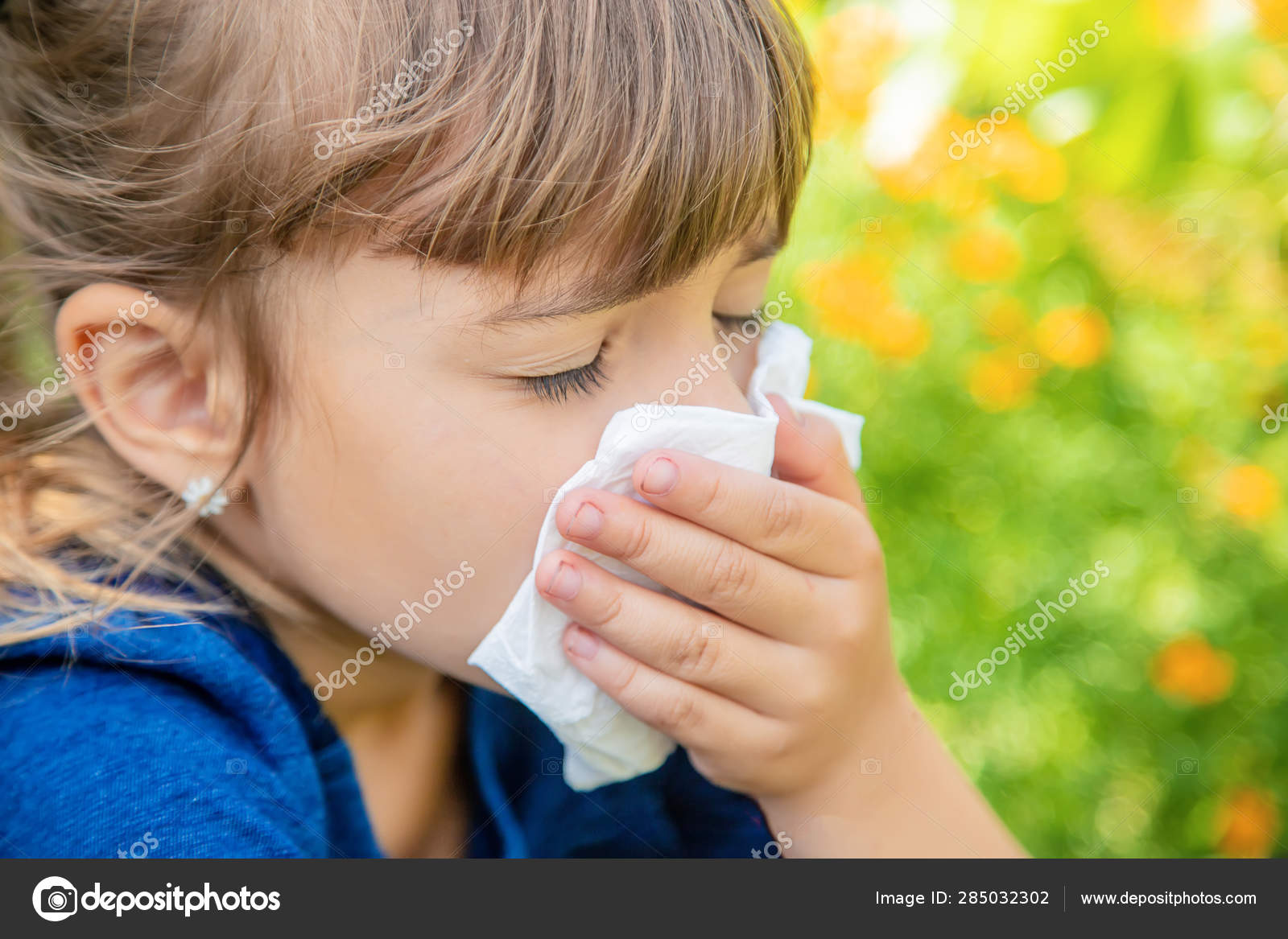 If you have a mold allergy, exercise caution when you use a humidifier. Aim to keep the humidity level in your home below 60 percent. Anything higher can cause mold to grow in your home.
If you have a mold allergy, exercise caution when you use a humidifier. Aim to keep the humidity level in your home below 60 percent. Anything higher can cause mold to grow in your home.
If you’re unresponsive to over-the-counter allergy medication or if your allergies cause you to cough or wheeze, you could suffer from more than allergies – which means it’s time to see a doctor. Allergies can turn into asthma or an upper-respiratory illness such as bronchitis or a sinus infection, so it’s important to see an allergist who can assess your symptoms and develop a tailored treatment plan, which includes testing you for food allergies, asthma, and other conditions.
90,000 Pollen allergy and flowering calendar
09/10/2020
Pollinosis is an allergic disease caused by pollen (from the Latin pollen – pollen). Sometimes you can find such names as hay fever, spring catarrh, seasonal rhinitis, pollen asthma, etc.
Its characteristic manifestations – seasonal allergic rhinitis and conjunctivitis, seasonal bronchial asthma, atopic dermatitis. In simple terms, allergic rhinitis manifests itself as severe itching and tickling in the nose, watery nasal discharge, paroxysmal sneezing and nasal congestion, rarely – a decrease in the sense of smell.Children may experience tinnitus and ear pain. Allergic conjunctivitis is characterized by itching in the eyes, lacrimation, redness of the eyes, a feeling of “sand” in the eyes, swelling of the conjunctiva (mucous membrane of the eyes), but without purulent discharge.
In simple terms, allergic rhinitis manifests itself as severe itching and tickling in the nose, watery nasal discharge, paroxysmal sneezing and nasal congestion, rarely – a decrease in the sense of smell.Children may experience tinnitus and ear pain. Allergic conjunctivitis is characterized by itching in the eyes, lacrimation, redness of the eyes, a feeling of “sand” in the eyes, swelling of the conjunctiva (mucous membrane of the eyes), but without purulent discharge.
Typical asthma attacks (seasonal bronchial asthma) are possible in 20% of cases. Skin manifestations are possible, typically on exposed parts of the body; often they are regarded by doctors as photodermatosis (skin reaction to the sun). Perhaps the development of urticaria, angioedema Quincke, seasonal pollen dermatitis with severe itching and various rashes.
Sometimes hay fever is accompanied by headache, fatigue, sweating, irritability, tearfulness, loss of appetite, sleep disturbance. Less common are chills, fever, damage to other organs and systems.
The most typical sign of hay fever is seasonality, the coincidence of manifestations with the flowering period of certain plants. In this case, the symptoms are repeated at about the same time every year, but since the flowering time is slightly shifted in different years due to weather differences, the timing of the manifestations of hay fever also changes.However, consideration should be given to the possibility of polyvalent pollen allergy (i.e. allergy to pollen of different plants), as well as the possibility of food allergy due to cross-reactions (for example, nuts in case of allergy to pollen from deciduous trees and shrubs). With allergies to molds, the phenomenon of hay fever can be observed all warm seasons. But most often, hay fever lasts no more than 4 weeks a year.
Prevalence
Pollinosis is common in people of all ages and genders, but it is more common in children over the age of 6.The number of patients worldwide doubles every 10 years. Pollinosis is not always diagnosed, therefore the official data on its prevalence are underestimated by about 10 times. Pollinosis does not go away with age.
Pollinosis does not go away with age.
Plants
About 60 plants play the main role in the development of hay fever. Knowing the approximate timing of their flowering in a given area facilitates the diagnosis of the “culprit” factor. Cross-reactions to related plants are possible (timothy – hedgehog, alder – hazel – birch). Usually there are three periods of increase in the concentration of pollen in the air: spring, associated with flowering trees (sometimes even the expression “wood hay fever” is found), summer (meadow grasses) and autumn (weeds).Of primary importance are wind-pollinated plants, the pollen of which is emitted in huge quantities and is easily carried by the wind. Its dimensions are from 10 to 50 microns, and the enzymes contained in it facilitate penetration through the mucous membrane of the eyes and nose. In addition, mold spores can grow on pollen grains, which can also cause symptoms. If hay fever is caused by fungal spores, symptoms can continue throughout the warm season.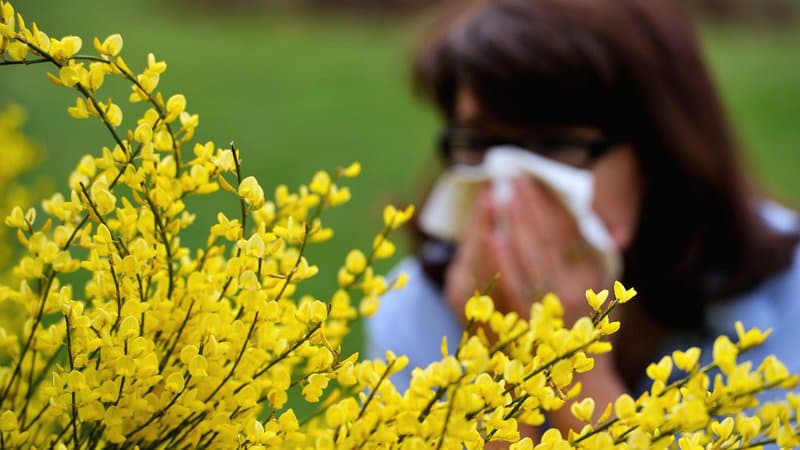
The causal factor of pollinosis depends on the climatic zone, the characteristics of the local flora.So, in Kazakhstan it is most often pollen of wormwood and ragweed, and in Russia – birch, hazel and meadow grasses. The flowering calendar of plants also depends on weather conditions. Symptoms are more pronounced on warm sunny days and strong winds.
It is possible to suspect the presence of hay fever by analyzing the coincidence in time of symptoms with the flowering calendar, and to confirm it, an allergic examination is carried out using skin tests (outside the flowering season) and an analysis for the presence of antibodies to this allergen in the blood serum (RAST – radioallergosorbent test, etc.).).
In urban dwellers, hay fever occurs 6 times more often than in rural residents. This is due to the influence of air pollution: under the influence of substances such as sulfur dioxide, ozone and nitrogen oxides, as well as acidic aerosols, pollen grains are damaged and new allergens emerge on their surface.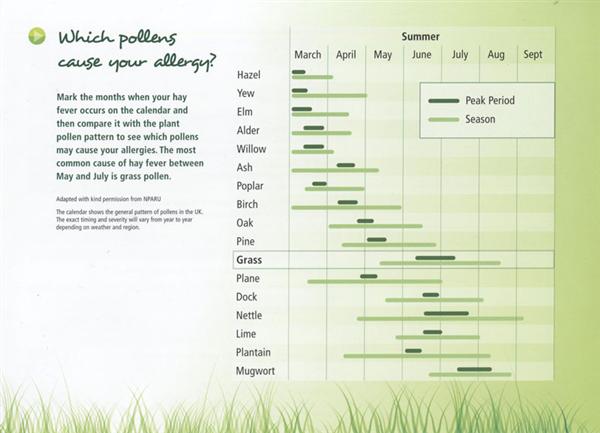
Flowering and sporulation calendar
On the territory of the European part of Russia, the blooming season is opened by the gray alder (in Moscow, on average, April 16).There is an interesting method for calculating hay fever from the sum of effective temperatures. Measures to limit contact with pollen should be started as soon as the temperature first rises to + 5 ° C, and the probable timing of flowering is calculated from the sum of effective temperatures (t ° effective = t ° average daily –5 ° C). For birch to bloom, the sum of effective temperatures must reach 70 ° C.
Foods that should not be consumed with hay fever
K pollen of trees
Nuts (especially hazelnuts), apples, cherries, cherries, peaches, nectarines, plums, carrots, parsley, celery, tomatoes (tomatoes), kiwi, potatoes, birch sap.
K pollen of cereal grasses
Bread, bakery products, bread kvass, flour products, semolina, bran, cereal sprouts, bread crumbs, ice cream, sherbet, puddings, dumplings, pancakes, rolled oats and cereals (oats, wheat, barley, etc. ), corn , sorghum, sausages, coffee substitutes, malt, beer, wheat vodka, sorrel.
), corn , sorghum, sausages, coffee substitutes, malt, beer, wheat vodka, sorrel.
K weed pollen
Melon, sunflower seeds, sunflower oil, halva, mayonnaise, watermelon, zucchini, eggplant, mustard, spinach, beets, absinthe, vermouth, lettuce, Jerusalem artichoke, chicory, citrus fruits, honey.
To fungi
Yeast dough, sauerkraut, beer, kvass, cheeses, wines, liqueurs, sugar, fructose, sorbitol, xylitol, and other products that undergo fermentation during cooking.
Relative plants within families (hay fever)
Birch
Birch, hornbeam, alder, hazel.
Plane
Platan
Beech
Beech, chestnut, oak.
Cereals
Soft wheat, sowing rice, sowing rye, corn, sowing millet, sorghum, barley, sowing oats, bluegrass, timothy grass, fescue, wheatgrass, foxtail, bonfire, feather grass, bamboo, reed.
Haze
Mary, quinoa, hodgepodge, beetroot, spinach, cochia.
Asteraceae
Sunflower, ragweed, lettuce, bitter wormwood, cornflower, thistle, calendula, aster, Jerusalem artichoke, succession, dahlias, zinnia, rudbeckia, marigolds, daisy, yarrow, chamomile, tansy, tarragon (tarragon), chrysanthemum, arvecillus, elecampane, coltsfoot, calendula, marigolds, artichoke, burdock, chicory, dandelion, butterbur, milk thistle, leuzea.
Plantains
Plantain
Know your allergen – 08/07/2018: information and educational site
Stuffy nose, sneezing, runny nose in the middle of summer, symptoms familiar to many. Seasonal allergy forces us not only to give up outdoor recreation, but also prevents us from fully living and working.
According to the “Association of Allergists and Clinical Immunologists” of Kazakhstan, the number of allergy sufferers in the republic every year increases by 10-15%.This increases the risk of developing severe allergies that can lead to disability.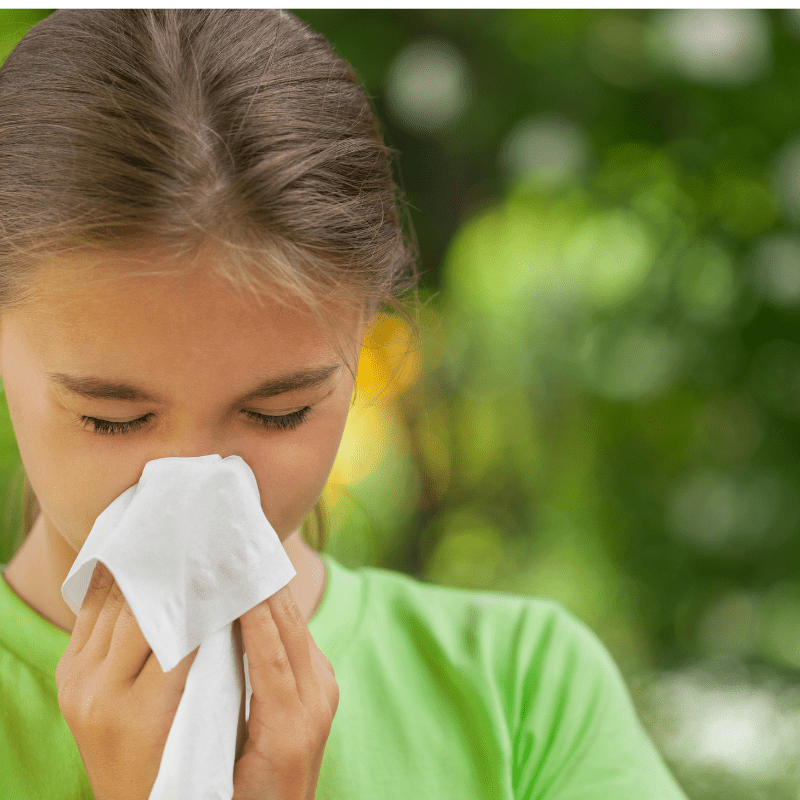 Almost one million Kazakhstanis suffer from bronchial asthma, which is more common in children.
Almost one million Kazakhstanis suffer from bronchial asthma, which is more common in children.
Aigul Syzdykova, an allergist-immunologist at the Hospital of the Medical Center of the Office of the President of the Republic of Kazakhstan, told us about why allergies should not be triggered and how they are treated.
– Aigul Amangeldyevna, what is the nature of allergies?
– Allergy is an increased sensitivity of the body to certain allergens.Someone’s allergen can be pollen, medicines, animals, there is a food allergy, everyone has their own intolerance. It is now August, so seasonal allergies are more common as weeds began to bloom. Basically, the cause of allergies lies in a hereditary predisposition and, if external factors are superimposed on this, – polluted air, unhealthy diet, frequent colds or viral infections, frequent use of antibiotics, even stress, all this can lead to such a failure of the immune system, when hypersensitivity occurs, hyperreaction to a specific allergen, there is a large production of immune complexes.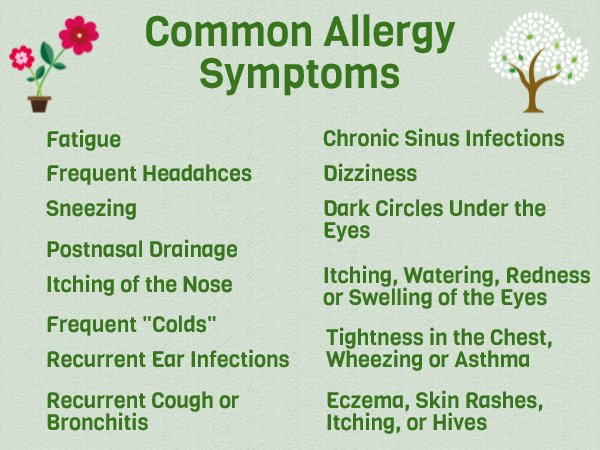
– In our latitudes, in particular in Astana, what causes seasonal allergies?
– In our latitudes, from March, April, to May, trees begin to bloom. The main allergen here is birch. During the flowering season, the flow of patients immediately increases to us. Then the season of meadow and cereal grasses begins, this is June-July. During this period, fescue, timothy, rye, and wheat are actively blooming. From the end of July, also in August and September, weeds already bloom: wormwood, ragweed, quinoa, chamomile, and this pollen is carried to Astana by the wind.Weed grasses, depending on the weather, can bloom until the end of October, before the onset of cold weather. Some people also have allergies in autumn, when fallen leaves are collected in the city, under the leaves there is mold, fungi, which also cause allergies.
– Which allergy is more common in Astana residents?
– In addition to seasonal flowering, drug allergies have often begun to occur, or girls use cosmetics, chemical dyes, tattooing, gluing, all this sensitizes, that is, makes the body more sensitive.
– Who is more likely to handle allergies, adults or children?
– People come to us all year round. Now, on average, 20-30 people come to one doctor per season, and we are two doctors, that is, the flow of patients is large. Many children have become allergic, whole families come to us, dad, mom see an adult doctor, and a child goes to a nursery.
– Sometimes an allergy manifests itself at a certain age, why does this happen?
– The age at which allergies are most often manifested is from 20 to 40 years.When the body is developing, the release of hormones. During this period, human immunity works at its maximum, that is, it uses all its reserves. With age, when the immune system decreases, the allergy disappears, since there is no longer such hypersensitivity as in youth.
– How not to provoke allergies?
– We allergists have such a concept as “elimination therapy”, which means that a person does not have contact with an allergen. If during the flowering period it is possible to leave, on an environment where there are no these herbs, where there is a different flowering calendar, closer to the sea, then it is possible to avoid allergy symptoms. If a person knows the cause of their food allergies and does not consume them, then again, allergy symptoms will not appear. But from the beginning you need to be examined and identify the causes of allergies and then eliminate contacts with them.
If during the flowering period it is possible to leave, on an environment where there are no these herbs, where there is a different flowering calendar, closer to the sea, then it is possible to avoid allergy symptoms. If a person knows the cause of their food allergies and does not consume them, then again, allergy symptoms will not appear. But from the beginning you need to be examined and identify the causes of allergies and then eliminate contacts with them.
– Do we have a paradise for allergy sufferers?
– Everything is individual, we always recommend going to the sea.But there are exceptions, we have patients from Bulgaria, on the contrary, it is easier for them in Kazakhstan, they come home and they develop allergies. Previously, we sent all patients to Aktau, where they felt relief, but now there are a lot of allergens in Aktau, perhaps because of the ecology.
– Can an allergy signal problems with internal organs?
– If there is any concomitant pathology in the body, especially in the gastrointestinal tract, disruptions in the production of enzymes, when food is not absorbed as follows, then this contributes to the manifestation of allergies.It is very important to treat seasonal allergies so that the spectrum of allergens does not expand in a person, because if it is not treated, then the body begins to react to common household allergens, such as house dust, wool, which later turns into a year-round form and we we are already getting a chronic disease. After all, the spectrum of allergens in humans can change, expand.
– Can allergies cause more serious illness if left untreated?
– Of course.Both drug and insect bite allergies – insect, also to pollen, can cause complications in the form of bronchial asthma, if a person has weak bronchi, anaphylactic shock, and even death. If, during an exacerbation of an allergy, you go out into nature, as it happens, on a fishing trip or on a picnic, then you can bring yourself to shock, when the pressure drops critically and the person is in a state of shock.
– What are the most effective allergy treatments you use?
– Today, allergy treatment is carried out using allergen-specific immune therapy (ASIT), so far nothing more effective has been invented in the world.Therapy is carried out only in winter, when there is absolutely no pollen in the air, and it resembles a vaccination for the production of antibodies in the body. We introduce an allergen to a person in small concentrations, the body is rebuilt and develops protective antibodies against it, and already during the flowering period, the patient develops immunity. The treatment is very long, from 3 to 5 years. That is, an allergy sufferer every winter for three months must receive this drug, the cost of treatment is from 80-90 thousand tenge. We use the vaccine produced in Russia.There are different types of vaccines in the world, for example, European, but in our country it is not registered, but in countries such as Germany, Italy, France, they are treated with them under the tongue. But the principle of therapy remains the same – allergens are introduced into the body in small doses.
– What drugs are used to eliminate allergy symptoms?
– Basically in the summer we prescribe sprays, tablets, these are antihistamines, this is all symptomatic therapy, so that there is no nasal congestion, swelling, obstruction, sneezing, coughing.
– Are these drugs prescribed individually?
– Although they are the same type of drugs, you need to look individually. Because a person may have concomitant pathologies, for example, polyps in the nose or sinusitis, these sprays will be contraindicated for him.
– What about pills?
– Antihistamines such as suprastin also need to be selected, each of them has its own side effects.Of course, Suprastin helps quickly, but it has a short effect of only 3-4 hours and often cannot be taken. In addition, they cause severe drowsiness if you are driving or watching the devices somewhere, it can be dangerous. Sometimes “suprastin” gives a complication to the heart, it can be harmful to nursing and pregnant women.
– What about food?
– There are cross food allergens. For example, the same pollen has the same molecular structure with some food product.If you are allergic to weed pollen, then it is imperative to exclude from the diet everything related to seeds, pollen: watermelons, melons, sunflowers and also honey. When there is an allergy, a lot of histamine is produced in the body and these products are histaminoliberators, therefore, during an exacerbation, we advise you to exclude them.
Allergists give each patient a memo with a list of allergy-causing products, as well as recommendations for antiallergenic hygiene.
Cross allergens.
Plant pollen – Nuts, fruits growing on trees and shrubs.
Grain pollen – Bread, bakery products, kvass, oatmeal, coffee.
Weed pollen – Melon, sunflower seeds, halva, mayonnaise, watermelon, zucchini, eggplant, mustard.
Mushrooms and microorganisms – Yeast dough, sauerkraut, beer, mold cheeses, wines, liqueurs, sugar, fructose, sorbitol.
A general hypoallergenic diet means avoiding foods such as citrus fruits, seafood, spices, honey, eggs, nuts, fresh milk, strawberries, raspberries, tomatoes, alcohol, carbonated drinks and chocolate.
Preventive measures for allergies.
1. Get an allergen diagnosis from a doctor. Avoid contact with the allergen!
2. Keep the house clean so that there is no dust or fluff.
3. When cleaning the house, in contact with dust, wear a gauze bandage.
4. If you are allergic to animals, do not keep them at home.
5. If you are allergic to medications, have a card with a list of medications to which you are allergic.
6. In case of pollen allergy during the flowering period outdoors, wear sunglasses and a hat. Coming from the street to take a shower, change clothes. From 12.00 to 18.00 it is advisable not to be on the street.
7. Preparations based on plants, food additives, cosmetics containing pollen or plant extracts are best avoided.
8. I am more likely to be outdoors in dry, hot or windy weather.
90,000 Allergist told how to distinguish hay fever from ARVI – Rossiyskaya Gazeta
In May and June, viral infections intersect with seasonal allergies.Omsk doctors explained how to distinguish a common cold from a hay fever.
The end of spring and the beginning of summer is a period of a stormy surge of nature and abundant flowering. Many people at this time suffer from hay fever – an allergy to plant pollen. However, the symptoms of this disease are very similar to those of the common cold. In both cases, patients are concerned about such manifestations of the disease as sneezing, itching and nasal congestion, watery discharge, itchy eyelids, red eyes and watery eyes.
Doctors note that this year they began to admit patients with clinical symptoms of pollen allergy already in April, when nothing is still in bloom.As it turned out, the townspeople reacted to fungal spores that appeared in the thawed patches.
– It is extremely important to make a correct diagnosis, because the methods of treatment for allergies and acute respiratory viral infections are completely different, – says the allergist-immunologist, assistant of the Department of Internal Medicine and Family Medicine of Omsk State Medical University Elena Nadia. -Therefore, at the reception, allergists often behave like Sherlock Holmes and find out the smallest details. If the above symptoms appear under the same conditions, for example, in the spring, summer and or autumn seasons, without an increase in body temperature and intoxication, then most likely there is a seasonal allergy.
With a viral infection, the symptoms increase gradually – within two to three days. And with allergies, a runny nose and redness of the eyes occur unexpectedly.
Colds usually last no more than two weeks. Allergy can “torment” the patient for months.
According to doctors, cross-reactions to food products can often occur if you are allergic to pollen. This is due to the similar structure of the pollen allergen and the specific product. So, with an allergy to birch pollen, an allergic reaction to an apple and other stone fruits and berries may occur.Sometimes in patients with hay fever, contact dermatitis occurs when peeling young potatoes or carrots. Medicinal plants, cosmetics containing herbs and tree oils can also cause similar symptoms.
Doctors must warn patients with already identified allergies about this.
Until the flowers: doctors are faced with an allergic “false coronavirus” | Articles
With the arrival of spring, parents began to confuse the symptoms of early allergy in children with coronavirus infection , doctors told Izvestia.We are talking about the so-called fungal allergy, which begins even before the flowering of trees in Russia, as well as about early hay fever. The symptoms of COVID-19 (like other acute respiratory viral infections) and allergies are really similar, the Center for Molecular Diagnostics of the Central Research Institute of Rospotrebnadzor told Izvestia. Some parents, at the first sign of a cold, begin to treat their children precisely for the infection. This is dangerous: incorrect therapy for allergies can contribute to the development of asthma, doctors warned. They recommend seeking professional advice.
Spring affairs
Along with spring, allergy sufferers meet their usual problems: n runny nose starts, eyes watery, cough may appear . However, if these symptoms first appear, particularly in children, they are often confused with respiratory viral infection . This is especially dangerous during a pandemic: drugs for ARVI have side effects, and an unidentified allergic reaction in time threatens the development of bronchial asthma , experts say. The opposite situation is also possible – an undiagnosed coronavirus in time can turn into a severe form. In addition, the patient is contagious to those around him.
It is possible to determine whether a child is allergic or not only after a timely examination of , Marina Vershinina, a leading expert of the CMD Center for Molecular Diagnostics of the Central Research Institute of Epidemiology of Rospotrebnadzor, told Izvestia. Sometimes even a doctor can find it difficult to solve this problem, since one disease does not exclude another, the specialist noted.
– Coronavirus infection in children is often milder than in adults. Symptoms may be subtle, blurry. First of all, it is necessary to assess the epidemiological situation: whether there were cases of infection in a kindergarten or school, whether someone from those with whom the child is in contact was sick in the last two weeks, she said.
Photo: Izvestia / Konstantin Kokoshkin
It is well known that the so-called fungal allergy begins even before the flowering of trees in Russia , noted Ksenia Bolgova, an allergist at the Medsi children’s clinic.Snow is melting, last year’s fallen leaves are bare, and a huge amount of mold spores gets into the air, she explained. Fungal spores are invisible to the eye, but can cause allergy symptoms: runny nose, cough, itchy eyes, the expert said.
– To protect yourself from allergic reactions to fungi and mold, contact with them should be avoided as much as possible . In the house, this is control over damp places in the bathroom or on the balcony, limiting the number of indoor flowers in pots, because the earth is a source of mold fungi, – advised Ksenia Bolgova.- On the street, you can protect the child with the help of the so-called barrier means, which will be prescribed by a specialist doctor. It is impossible to self-medicate, because the symptoms of the disease may worsen.
A little later, allergy to tree pollen begins – hay fever . If symptoms begin for the first time, are also often confused with a respiratory viral infection, including coronavirus , experts say.
Special signs
A specific symptom of coronavirus infection is loss of smell and taste.In children, this symptom may be mild or absent. With allergies, the child may also feel worse smells, but a decrease in the sense of smell in this case will be due to inflammation and swelling of the mucous membrane. Once the symptoms go away, the sense of smell will be restored. Also, with allergic rhinitis, there is abundant mucous discharge from the nose, redness, congestion, itching.
Given the current epidemiological situation in the world and in Russia, parents often experience any, even minimal symptoms of symptoms, Ksenia Nurullova, an allergist-immunologist at the Medsi children’s clinic, confirmed to Izvestia.Many believe that this could be a manifestation of a coronavirus infection, she explained.
Photo: Depositphotos
– The anxiety of the parents is quite understandable, since the diseases are similar. In any development of the situation, the best recommendation would be to contact a healthcare professional. Since improper treatment or treatment of the wrong disease can worsen the child’s condition . The lack of compensation for the minimal manifestations of hay fever can lead to the onset of bronchial asthma, the allergist emphasized.
The Center for Molecular Diagnostics of the Central Research Institute of Epidemiology of Rospotrebnadzor told that distinctive signs of an infectious disease are symptoms of intoxication . These are lethargy, tearfulness, decreased appetite, headache, sometimes nausea and vomiting, fever . With allergies , even against the background of pronounced inflammatory reactions , there are no symptoms of intoxication , experts noted.
Painful combination
It cannot be ruled out that a child may have two diseases at once: an allergy and a new coronavirus infection. However, allergy sufferers are less likely to be infected with COVID-19 , according to a study by an international group of scientists, which included specialists from the Sechenov University, the University of Giessen (Germany), the Center for the Study of Lungs in Marburg (Germany), etc.
Photo: Izvestia / Dmitry Korotaev
– We have an assumption that the type of inflammation characteristic of allergy sufferers – Th-2 – is protective (protective. – Izvestia) in case of coronavirus, – said the head of the Department of Clinical Immunology and Allergology at Sechenov University, Alexander Karaulov.
However, this issue still requires further study, he noted. As for seasonal allergies and coronavirus, all experts insist that it is necessary to see a doctor in order to avoid incorrect prescriptions.
Spring. Season of allergic reactions
Seasonal allergy is an allergic reaction that occurs at a specific time of the year. It can be expressed either in the form of seasonal rhinoconjunctivitis (just conjunctivitis) and rhinitis, or in seasonal pollen asthma.The reason for the appearance of seasonal allergies is the pollen of various plants: trees, grasses, cereals, asteraceae, spores of some fungi. People suffering from seasonal, and indeed any allergies, often wake up at night due to discomfort, suffocation, which interferes with normal sleep. Several such nights – and, behold, you already have a sleep disorder. Nervousness, irritability arises, 2-3 sleepless nights can develop hysteria or hyperactivity in your beloved child.
Jokes with allergies are bad, it can have quite serious consequences, causing both mild manifestations of conjunctivitis or rhinitis, and (with the progression of the allergic process) the development of seasonal pollen bronchial asthma, which has several stages of the course – mild, moderate and severe.If the allergic process is left unchecked, left unchecked, and many patients usually do this, a more serious reaction may occur in the form of bronchospasm, otherwise bronchial asthma.
Seasonal allergic reactions can occur in people suffering from tree pollen anywhere from mid-April to late May, early June, early summer to mid-July; further on, Compositae grasses take over the baton – from mid-July to almost the first snow. Such periodicals are connected with the fact that the dusting of various plants has strictly defined dates.The concentration of allergens in the air does not depend on the time of day. The flowering period itself matters, for example, the most active period of dusting of birch – the most allergenic tree – is the end of May, then the amount of pollen grains per cubic meter decreases, but pollen is still present in the air.
The concentration of pollen depends on the vegetation that prevails in a particular area. If you suffer from seasonal allergies and at the same time live near a forested area dominated by deciduous trees, especially birch trees, you will be much worse endure the period of dusting than, say, in an area where conifers grow.
The first place among allergenic, “harmful” trees is occupied by birch, followed by alder, hazel, maple, and ash. The notorious poplar, which is accused of everything and everyone, as such, does not cause allergies at all, in any case, during my practical activity, I have not met patients with an allergy to poplar. In fact, during the ripening of his puffs, and this is the beginning of summer, the period of flowering of cereal grasses begins. These puffs collect the remaining pollen from trees and grass pollen, carrying out their mechanical transfer.It is pollen that is the real culprit for allergies.
The drugs used to treat seasonal allergies can be divided into several groups.
Antihistamines, antiallergic drugs , which can be used both locally (drops, sprays) and taken in tablets (systemic administration of antihistamines). Now on the pharmaceutical market there are many antiallergic drugs, so the choice of a drug requires a doctor to have a deep knowledge of their features and application possibilities.When prescribing treatment, the doctor should pay attention not only to the effectiveness of the drug, but also to the possibility of developing side effects. The second group of drugs – the so-called “cramons” , these drugs suppress allergic inflammation or “allergic cascade”. These are usually sprays, nasal drops, or eye drops.
The third group is glucocorticosteroid preparations for local and systemic effects. Systemic drugs are hormonal drugs that must be taken in case of ineffectiveness of other therapy.Topical (topical) steroids are usually nasal sprays or eye drops, the former being used more frequently.
Sorbents, which help to remove allergens entering the body through the mucous membrane and gastrointestinal tract, have a great effect in complex therapy (Lactrofiltrum, Entoras-gel, activated carbon). Perhaps these are the most important groups of drugs that are used to treat seasonal allergies.
Specific immunotherapy is another treatment that produces protective antibodies.It is usually carried out outside the dusting season with allergens identified in Russia. One course of treatment with specific immunotherapy includes 35 to 40 injections. Such treatment is carried out, as a rule, up to 50 years, after this age barrier, the response of the immune system is considered ineffective. Specific immunotherapy can be performed annually if the desired effect has not been achieved after the first course of treatment. If there is a good effect and in the next season of dusting there is only a slight symptomatology of hay fever, then you can take a break for a long time, and then, when the symptoms intensify, return to this course again.
Aerosols used for seasonal allergies are different. For example, aerosols containing cramones that block the allergic cascade can be used as much as needed. In this case, there is no addiction, there is no danger of overdose, they can be used for a long time. The use of topical steroids, however, will depend on the specific situation. With seasonal allergic rhinitis, it makes sense to start using these drugs ten days before the expected dusting, the entire dusting period and another ten days after the end.There are cases when such drugs are used even for more than a year, but I believe that there is no urgent need for this.
Significant influence on the state of allergy sufferers during the flowering period of plants, trees, grasses is exerted by meteorological factors. In rainy weather, pollen is nailed down and its concentration in the air is significantly reduced. Windy, dry weather contributes to the long-term maintenance of a high concentration of pollen.
Indoors, the concentration of pollen is less than outdoors, so allergy sufferers feel much better indoors.But if a person uses, say, a private car and drives with open windows or, for example, opens windows indoors, then the concentration of pollen in the street and indoors may be identical, and the person will feel bad in any case, no matter where he is in.
Recommendations for people suffering from seasonal hay fever are not limited to therapeutic measures and symptomatic therapy. The climate is important: if a person leaves for a region where dusting has already ended, he will calmly survive this period, returning back only to its end.You can try to reduce exposure to allergens by installing air purifiers, cleaning carpets every day, maintaining a certain humidity in the apartment, but this is often ineffective or requires excessive physical and material costs. During the flowering period, you can wear a cotton-gauze bandage, especially when working in summer cottages. Keep doors and windows closed, install a special air intake on the window with an allergy filter. Get rid of carpets. Start taking preventive medications a few weeks before the main flowering of plants.
Remember that no two people are alike. Your doctor can determine what is the allergen for you and how best to treat the symptoms of your allergy. By giving your doctor detailed information about your lifestyle and habits, you can help him more accurately identify the problem and give you advice on how to alleviate allergies.
90,000 Dangerous beauty. Allergy season is in full swing
May 8, 2020 at 12:55 pm With the onset of spring, nature is transformed. And if for some people this is the time of admiring flowering trees and shrubs, for others it is an exacerbation of seasonal allergies.
About how they manifest themselves, what kind of treatment they require, what is necessary for prophylactic purposes, the allergist-immunologist of the Tiramed Medical Center, Lyudmila Bidyuk, told us.
– Which season is considered the most difficult for allergy sufferers and why?
– An allergic reaction can occur at any time of the year, individually each “allergic” has its own spectrum of allergens. Someone reacts to the flowering of trees (spring: April – early June), someone to the flowering of meadow grasses (late June – July), there are patients with a reaction to weeds (mid-July – October), a reaction to mold and dampness ( October – before the onset of frost and the end of February-March), polyvalent sensitization is possible, i.e.e. a year-round variant of the course of the disease. Especially with concomitant sensitization to house or library dust, animals, food products, medicines, occupational factors.
– What plant allergens are typical for Transnistria and most often bother citizens?
– Birch, poplar, hazel, chestnut, willow, linden, conifers, oak, maple; wheatgrass, dandelion, hedgehog, foxtail, timothy, wormwood, ragweed, quinoa, plantain.For some patients, even the flowering of fruit and vegetable crops, incl. nightshades, sunflowers, corn – can cause an exacerbation of the disease.
– What symptoms indicate specifically seasonal allergies?
– One or more of the following symptoms may indicate it: sneezing, difficulty in nasal breathing, mucous discharge from the nose, itching of the tip of the nose, itchy eyelids, redness of the eyelids, swelling of the eyelids, watery eyes, foreign body sensation in the eyes, irritation, etc. dry mouth, throat, hoarseness, coughing, dry cough, rare or frequent paroxysmal, with difficult sputum, shortness of breath, wheezing, and in some cases, a rash on open areas of the body.Similar symptoms occur at approximately the same period of the year, i.e. during flowering in spring or summer, early autumn.
– What symptoms require immediate medical attention?
– You should immediately seek medical help in case of a dry paroxysmal cough, feeling short of breath, shortness of breath, wheezing, swelling of the eyelids or other area: lips, nose, neck.
– In some cases, allergy to flowering plants is accompanied by a reaction to certain foods, what to do in this case?
– This reaction is called cross reaction.For example, in case of a reaction to birch pollen, it is necessary to exclude the consumption of apples, to plant pollen – honey and beekeeping products.
– Is there a particular risk for allergy sufferers due to the spread of the coronavirus?
– Coronavirus and any other infection (viral or bacterial) can cause the development of exacerbation and complications in allergy sufferers.
– How to distinguish coronavirus from seasonal allergies?
– A doctor can distinguish coronavirus from seasonal allergies by the presence of complaints and a known allergic history, when examining a patient, as well as carrying out some laboratory and instrumental examination methods.
– There is a state of emergency in the country and many are on self-isolation. Could this measure significantly reduce seasonal allergies?
– Self-isolation mode will prevent the spread of infection, which is unacceptable for people suffering from seasonal allergies, because this can aggravate the course and cause the development of complications of an allergic disease. During the flowering period, you need to limit your stay outdoors in dry hot weather and in the morning, because the concentration of allergens is highest at this time.It is permissible to conduct airing in the evening, while moistening mosquito nets with water.
– What other measures will help protect against allergies during the flowering season?
– You should refrain from hiking in the woods, trips out of town. If possible, it is better to travel to other climatic zones, using the plant flowering calendar. In the apartment and at work, you need to close the windows tightly. When going outside, it is recommended to use sunglasses, and when returning home, wash your face, mucous membranes of the nose and eyes, take a shower, rinse your hair especially thoroughly.Do not open windows in the car, use special anti-pollen filters for air conditioners. It is also important to carry out wet cleaning in the apartment on a daily basis, to exclude the use of food with cross-reactivity, not to use phytopreparations, food additives, cosmetics containing pollen and plant extracts.
– The Unified Medical Information Service receives questions about your profile. What problems are citizens now addressing?
– At present, seeking help is mainly for rhinitis, conjunctivitis, dermatitis, reactions to insect bites, urticaria.
– Allergy to ragweed is quite common in our country. What is this plant and why is it dangerous? When to wait for the peak and is it possible to somehow prepare the body for it?
– Ambrosia is one of the most harmful weeds and the most dangerous allergens in the world, destroying everything around it with incredible speed. The pollen of this plant has an allergic ability. The peak of flowering, and hence the deterioration of well-being in people sensitive to weed pollen, occurs at the end of July and continues in our region until the middle, and sometimes until the end of October.
It is necessary to prepare the body before flowering. The amount of necessary therapy is determined by the allergist individually for each patient, taking into account the existing clinical manifestations in the previous year. Those. before signs of exacerbation appear in a given year, because the disease is easier to prevent than to cure.
Ministry of Health of the PMR
You can turn the pages using the ← and → arrows on the keyboard.
Lisa magazine: 5 signs of hay fever
Summer, and especially its first half, is not the best time for allergy sufferers suffering from hay fever.In June, birch blossoms, the pollen of which is the strongest allergen; in July, the flowering of cereals continues, and weeds bloom until the end of August. However, it can be very difficult to distinguish hay fever from a common cold. Ekaterina Korchinskaya, an expert at the Center for Molecular Diagnostics (CMD) of the Central Research Institute of Epidemiology of Rospotrebnadzor, told Lisa magazine how to recognize seasonal allergies by five characteristic signs and prevent its development.
With allergies, coughing occurs due to contact with allergens.If a cough bothers only in certain months, then, most likely, it is caused by an allergy. As a rule, an allergic cough is dry and occurs mainly at night. And with a cold, a cough occurs only at the beginning of the disease and after a few days it becomes wet. In addition, a common cold usually lasts no more than two weeks, and hay fever can last for months.
With SARS, a sore throat is caused by inflammation of the lining of the nose and throat. When a person is allergic, it is not the pain that worries, but the “tickling” in the throat.
Also, seasonal allergies are characterized by a specific rhinitis, when a watery liquid is constantly secreted from the nose. With a cold, the color of the discharge gradually changes to yellow or greenish.
Another common symptom of allergies is lack of fever. This is because the amount of hormones causing the inflammatory response is not large enough to affect the thermoregulatory center.
In addition, allergens, unlike pathogens, do not cause intoxication.Therefore, with hay fever, there is no muscle aches.
Allergy symptoms – runny nose, conjunctivitis, sore throat, cough and skin rash – are reactions caused by the immune system that tries to stop the spread of allergens in the body.
In case of hay fever, it is necessary to consult an allergist and take anti-allergenic drugs as prescribed. Also, during the flowering season, it is necessary to ventilate the apartment as often as possible and carry out wet cleaning, and after a walk, it is advisable to take a shower and wash clothes every time so as not to “wear” allergens on you.
Lisa magazine
.




